1lumen selects and reviews products personally. We may earn affiliate commissions through our links, which help support our testing.
Gearlight S2000 review: popular Amazon flashlight
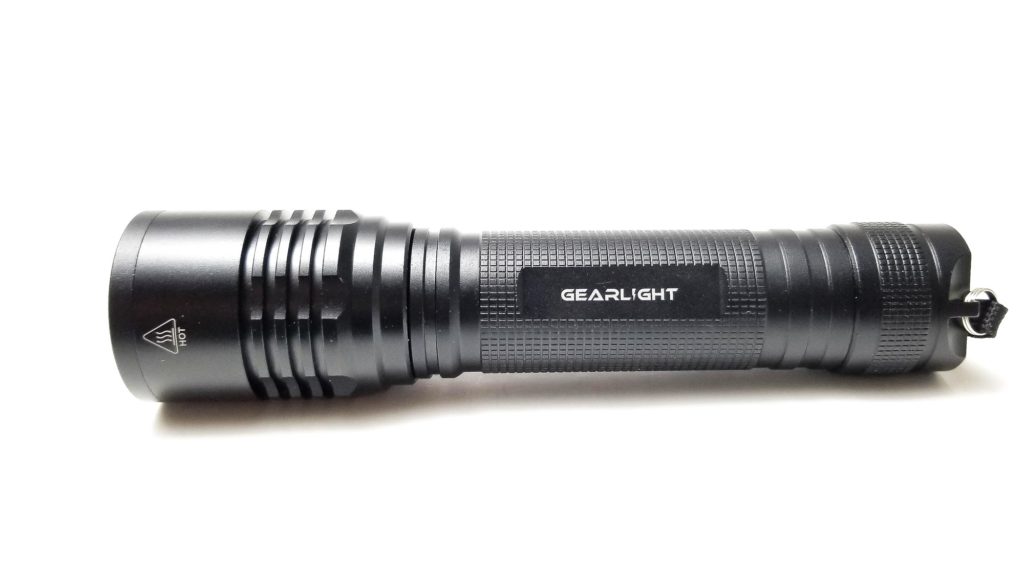
Gearlight S2000 specifications
| Brand/model | Gearlight S2000 |
|---|---|
| LED | Not specified |
| Max. Lumens | Not specified |
| Max. Beam intensity / distance | Not specified |
| Battery config. | 4*AA |
| Onboard charging | None |
| Modes | 3 |
| Blinkies | None |
| Reflector | Aspheric lens |
| Waterproof | Not specified |
| Review date | April 2022 |
Introduction:
What’s this? Another cheap flashlight on deck for review? I must be a glutton for punishment because today I’ll be taking a look at the Gearlight S2000. This is Gearlight’s flagship flashlight, advertised as their “biggest and brightest.” If you’re an enthusiast reading this, or someone somewhat-familiar with the flashlight hobby, you’re probably thinking, Gear-who?
Well, you aren’t alone because my first experience with a Gearlight product was reviewing the Gearlight S1000. Even though it’s a typical cheap zoomie, it’s pretty special in that it holds the distinction as the most popular flashlight on Amazon. How popular? Well, when I reviewed it a few weeks ago, it had a bit over 61,000 reviews. Today, that’s ballooned to 62,502 reviews with an average rating of 4.7 out of 5 stars, it seemed like a sure thing. However, although it does what a flashlight does best, after running it through my battery of tests, I found it to be just okay and gave it 2.5 stars. Nope, Amazon is not always right, nor the best place for product reviews (but we already knew that, right?).
Like its smaller stablemate, the Gearlight S2000 comes in with a healthy 22,000 reviews and boasting a similar 4.7 out of 5 star review average rating, and it has a lot in common with the S1000: It’s a push-pull zoomie, takes Alkaline or NiMH batteries (rechargeable batteries), and it’s cheap…well, with a caveat since it’s several bucks more expensive than the dual-pack of S1000s. We all know more expensive and bigger doesn’t mean better, but hey, 22,000 reviewers and a 4.7 star cumulative score can’t be wrong, right? Let’s see. I don’t have high hopes, but I’ve been surprised before.
So, is this really one of the best flashlights on Amazon?
Package quality.
The S2000 comes in a super-plain box covered with graphics and feature blurbs, but that’s about it. Inside, the light came wrapped in bubble wrap and unlike the S1000, save for the attached lanyard, it’s devoid of accessories (plus you only get one this time):
- Gearlight S2000
- Manual
- Lanyard (attached)
Well, they had to cut costs somewhere, but I’m a bit surprised that there’s no batteries included (just like the S1000), and I am a little bothered by that because AA batteries are cheap. Even $1 WalMart flashlights come with batteries. The lanyard was preinstalled and it’s cheap, but works.
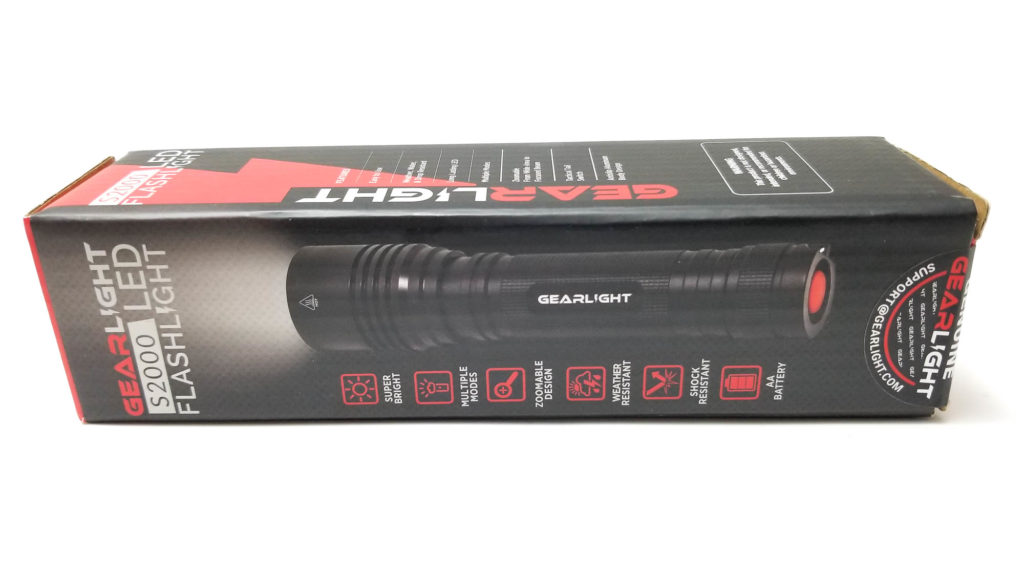
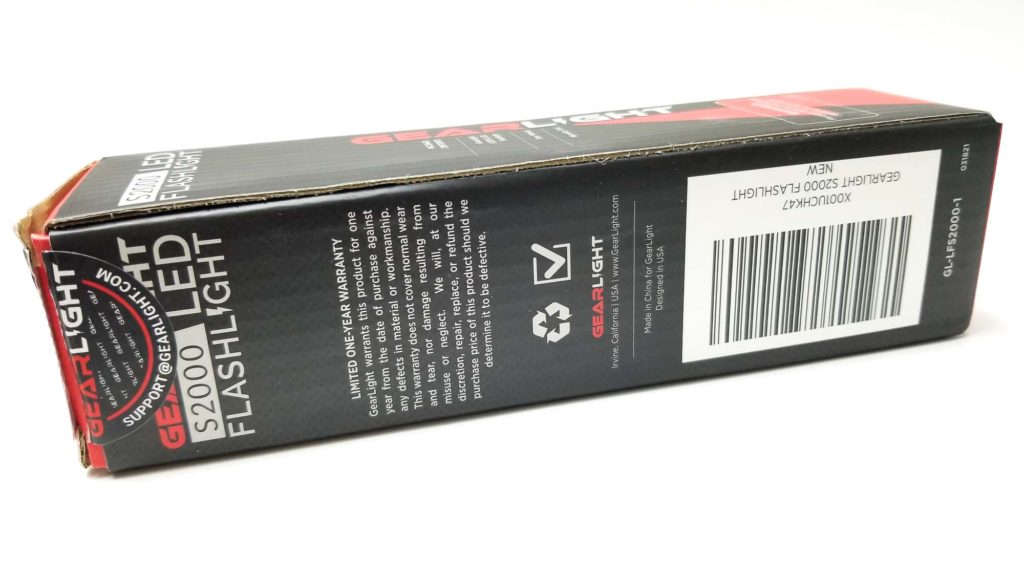
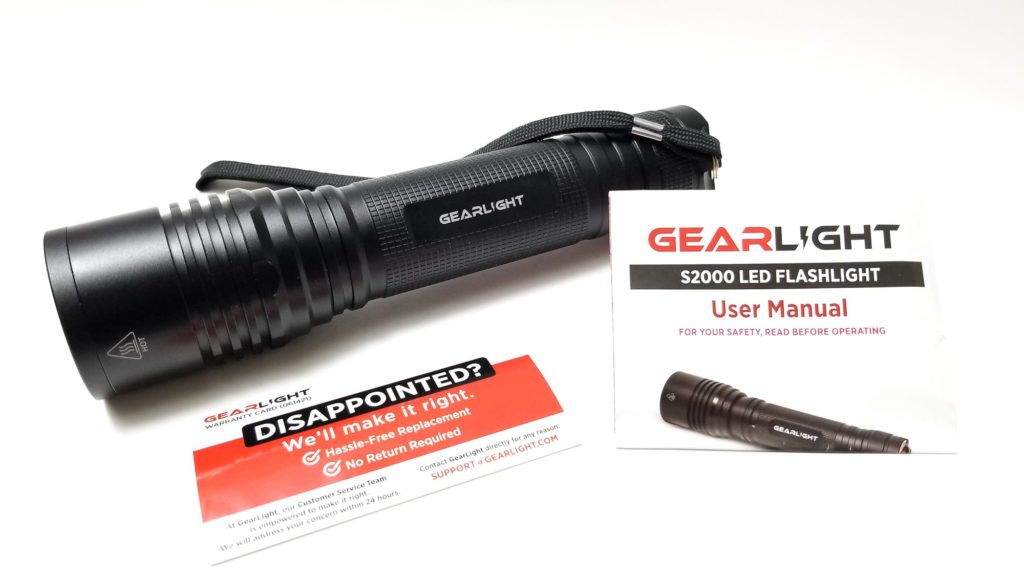
Flashlight in use
The S2000 is a variable focus flashlight, or a ”zoomie” in flashlight slang, and more of a general use light that can fit a variety of use cases: Walking at night or searching for your lost shaker of salt? Yep, the S2000 can help with that. What it isn’t is a tactical flashlight or a high performance enthusiast light, and we all know how enthusiasts thumb their noses and give zoomies a wide berth. The S2000 is a push-pull zoomie, so the entire head slides forward and backwards to adjust the beam from spot to flood. The travel is about 1.5 inches, so there’s lots of adjustability to have as much or as little flood as you want, or fully extended for spot. The zoom action is really smooth.
The S2000 is a large, standard tube light, and what struck me right off the bat is the size. It’s pretty big for a 4xAA size light. It’s a bit longer than a 3D Maglite, about the same size (length and width), and almost as heavy as my 2×26650 size Wurkkos DL70. It’s also bigger than an Astrolux FT02S and positively dwarfs a C8-size light as well. That said, for larger-handed folks, it fits well in the hand and is pretty maneuverable. The balance is also okay, but not like a properly-balanced light. The tube is a bit chubby, but this is good for maintaining a good purchase on the light. However, that added length combined with the zoom head and single rear clicky switch make this a two-handed light like the Convoy L7. The rear switch is a reverse clicky, so it must be fully depressed and released before the light turns on. The click action feels okay and while a bit mushy, and a little vague, it’s serviceable. The boot is a bit thin and I could easily feel the switch underneath. Interestingly, the head has lots of heat sinking fins for good thermal management (although it’s sort of pointless…read on for why).
The tailcap and body have rolled-in texturing for grip, and there’s a single lanyard hole in the tailcap. There was a cheap lanyard attached with a split ring from the factory, and it seemed pretty sturdy, but I doubt it would handle real abuse. I ended up ripping it off, and it took quite a bit of force, so I doubt it would break under normal use. Retention wise, unlike the S1000, there’s no holster, and that’s too bad because it needs one. It’s too big for a pocket, and it wouldn’t fit very well in a cargo or jacket pocket either. Tail standing is easy-peasy and stable. There’s not much anti-roll prevention on the light, so it will roll off an uneven surface.
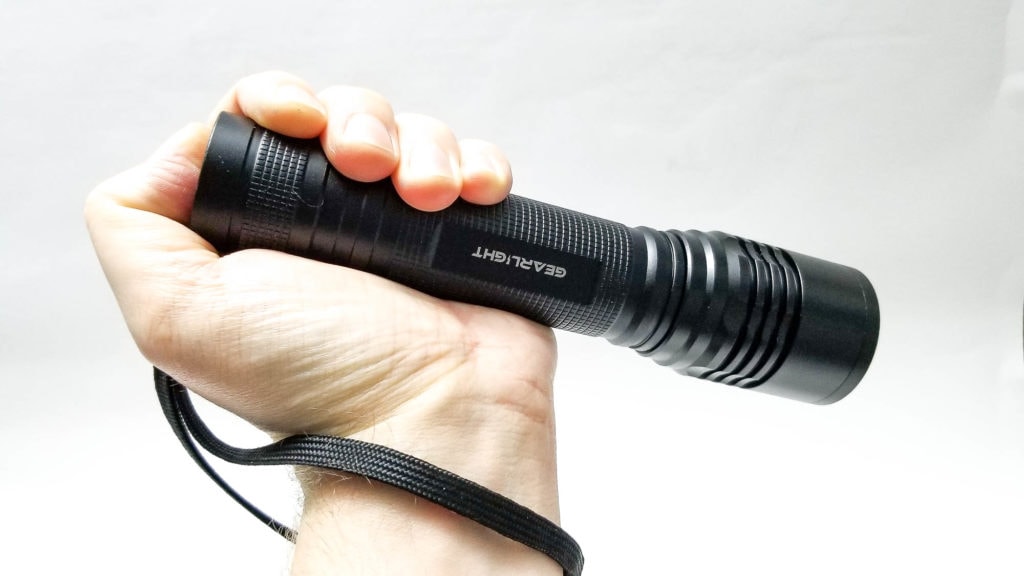
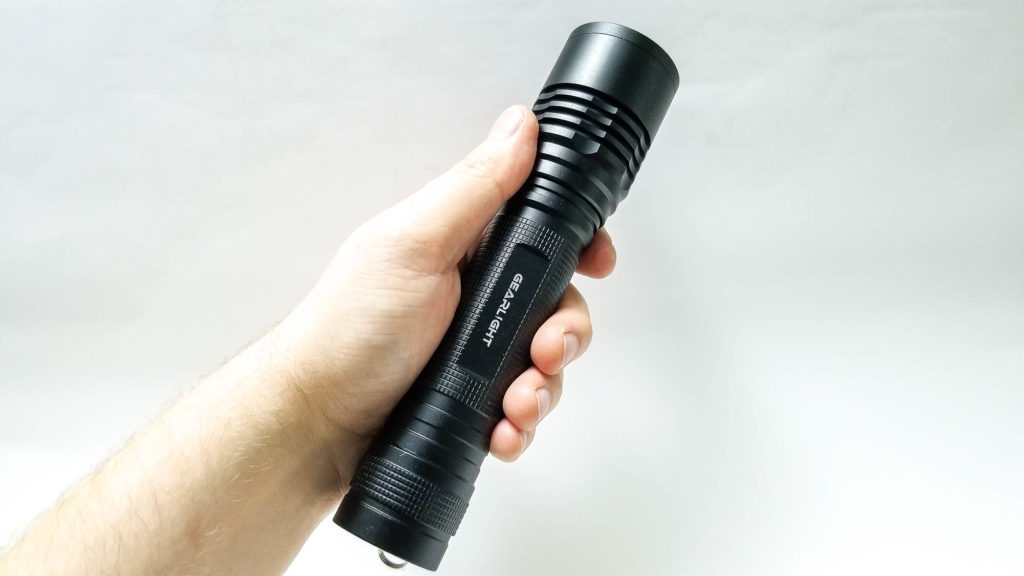
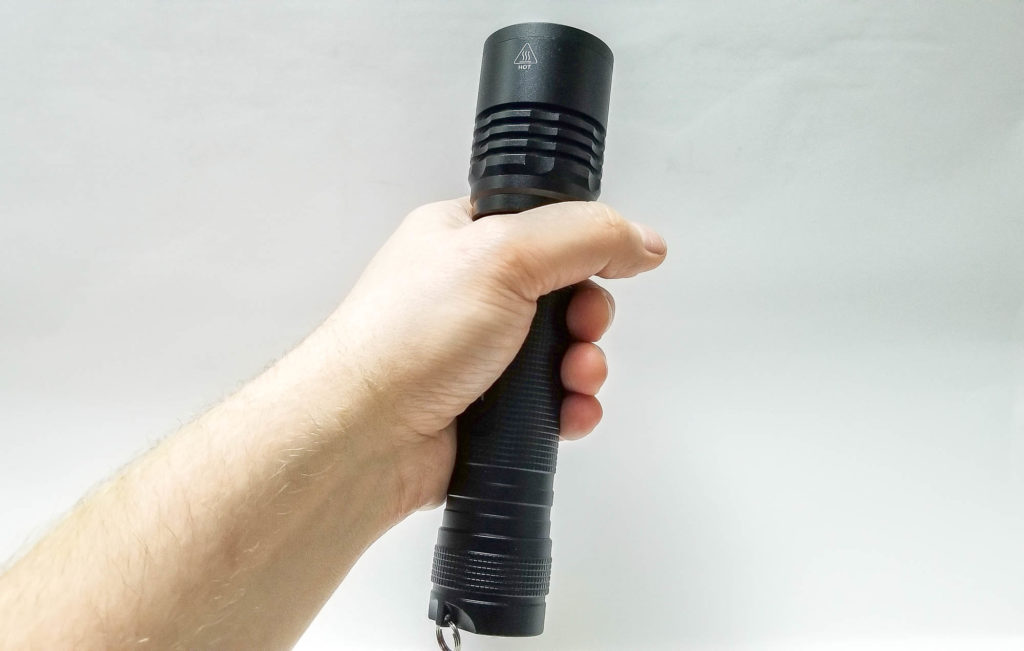
Build Quality, and Warranty
Generally, manufacturers cut corners to keep the cost down, the cheap lights are carefully planned to price point, and this is evident in the S2000. It currently sells on Amazon for about $22 US (without shipping), which seems like a good deal for Gearlight’s “biggest and brightest,” but don’t let that fool you because something like a Convoy C8+ or M21A, or any other C8 variant, runs about $25-$30. Other alternatives include the Astrolux EA01, Sofirn SC31T and SP35 for around $35 (on sale). All of those are fantastic budget and entry-level lights with vastly superior performance and advanced feature sets.
Okay, quality, fit and finish: The S2000 isn’t terrible, but that said, you definitely get what you pay for. In an economy when $22 gets you McDonalds for two, what exactly does your hard-earned $22 get you? The light is constructed from “virtually indestructible military-grade aluminum” (from the listing). The edges are smooth and chamfered, and the machining is good enough. The finish seems like real anodizing instead of paint, and it’s a decent matte finish. I didn’t see any major issues with coverage or defects, and it’s what I expect on a cheap light with the usual shoddy coverage near the rear threads. So far, the finish has held up okay, but I doubt it’s as durable as a true MIL-STD type III HA.
The humongous cell carrier is made from pretty sturdy plastic and looks like it’s held together with philips screws. I didn’t try to take it apart, and it looks like it was designed to hold more batteries. There’s a thin steel spring with a gold-like plating on the driver side, and the tail has a brass slug-spring-loaded piston “plunger” contact like I see on other cheap lights. The battery carrier has gold-plated springs for the negative contacts and bumps for the positive contacts. There’s steel strips for the series connections, and the positive end that contacts the driver-side contact consists of an entirely superfluous and unnecessary spring-loaded plunger like the tailspring. A flat contact would be a much better solution here. It’s definitely not a low-resistance current path, and I think it could benefit from that.
I felt like I’d be doing myself (and you readers) a disservice by not taking apart the S2000, so here we go! The light can be completely disassembled. The bezel unscrews to release the aspheric lens and the gigantic (surprisingly with a 2 mm thick LED shelf) pill unscrews with needle-nose pliers. Once the pill is liberated, off with the head since the whole zoom head comes off and the pill can be pushed out from the rear. The head’s not connected to the body and it slides on two o-rings on the pill to provide resistance to the movement.
This means there’s no thermal path to all those wonderful heat sinking fins.
The white plastic retainer holding down the MCPCB can be freed with some love taps with a hammer and thin metal rod from the driver-side. The LED sits on a roughly 25 mm diameter 2 mm thick aluminum MCPCB stuck on with a pathetic dab of China’s finest cheap white thermal grease. The LED wires are tiny, maybe all of 26 awg, but they are the superior silicone insulated type. The rear switch comes out after unscrewing an aluminum retaining ring and no surprise, it’s a white plastic knockoff Omten 101 clicky switch. If one were so inclined to polish a turd, there’s room for mods here: driver, LED swap, add some thermal mass to the pill, but that’s about it. You’re limited to AA NiMH cells for current handling, which is not ideal for current demands over about 3.5 amps. The rear threads are bare, fine triangular cut and pretty short. If these are lubed, it’s a new fancy kind of lube that’s invisible and doesn’t work. The threads weren’t the smoothest, but functionally, they worked. There’s no claimed IP rating, and zoomies aren’t known for being waterproof, but I’d imagine it’s somewhat water-resistant, but don’t count on it surviving toilet-drops.
The warranty? Since the S2000 is sold exclusively through Amazon, you are afforded Amazon’s excellent return/exchange policy. There is a warranty card in the box as well, with a support line and a guarantee on functionality with the assurance that If it breaks or malfunctions, send it back for a refund or replacement. It’s a better warranty support than some other Chinese sellers, and better than some higher-end brands. I love being able to take an Amazon purchase to a department store for free return shipping. Send it and forget it.
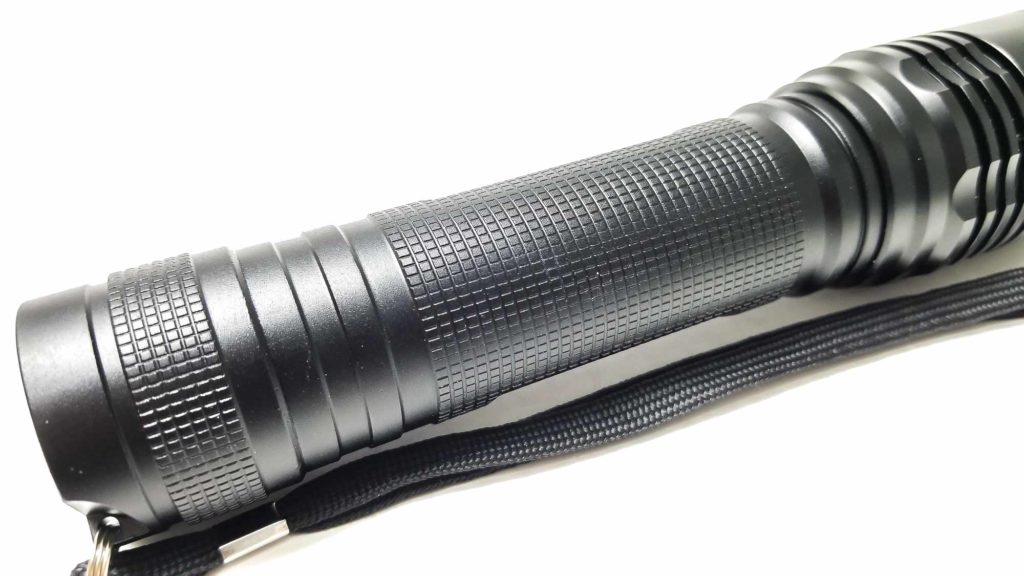
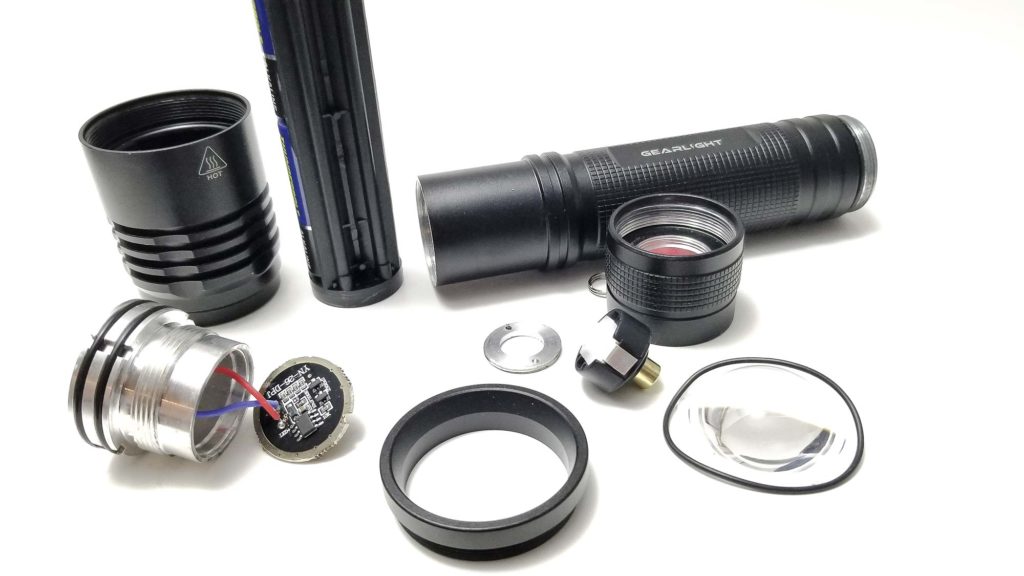
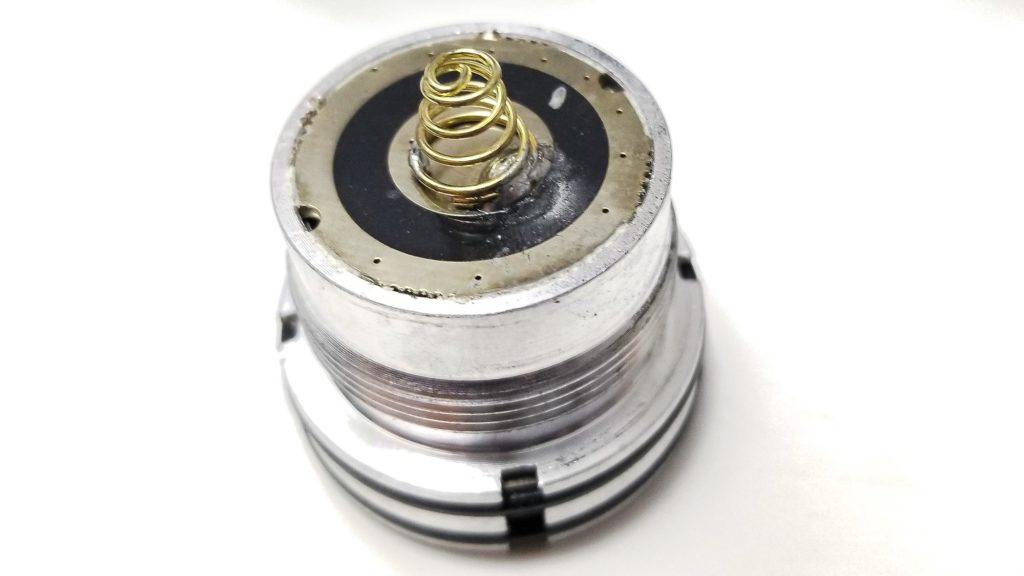
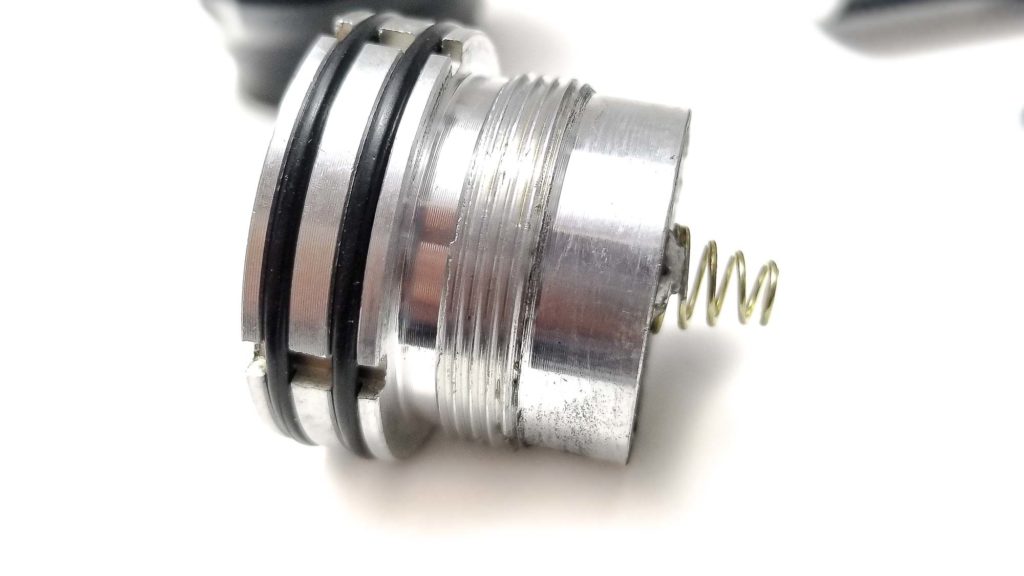
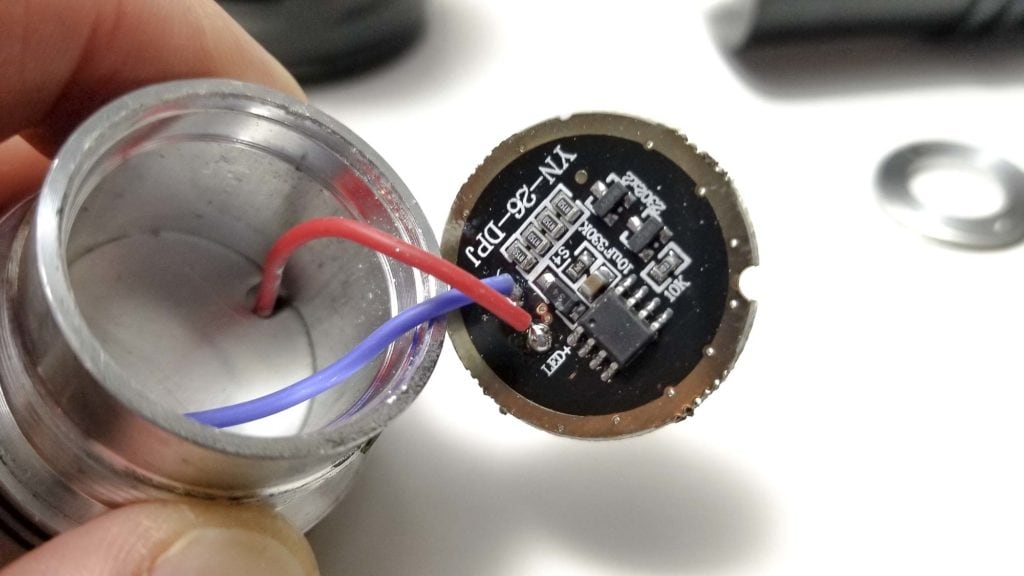
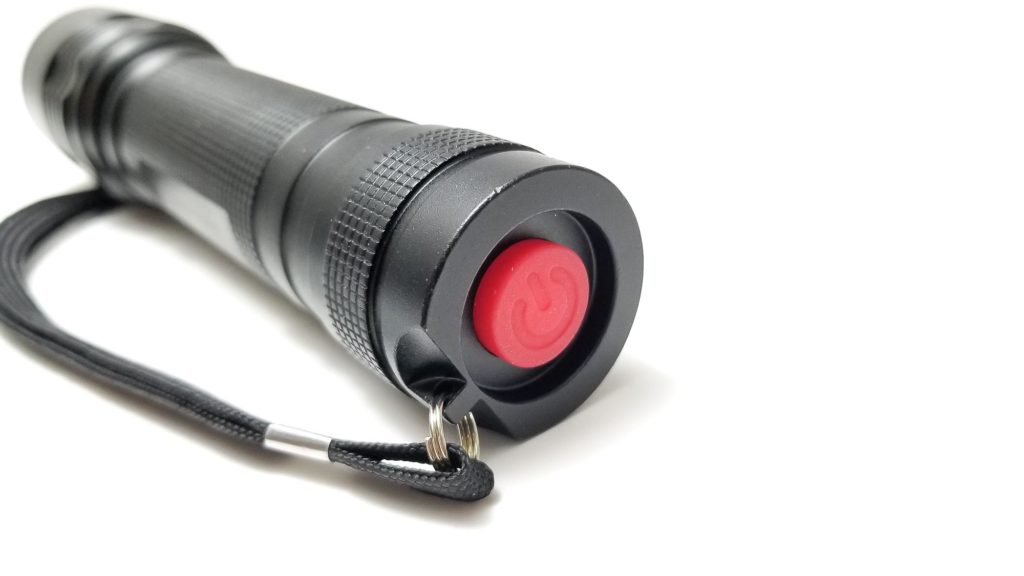
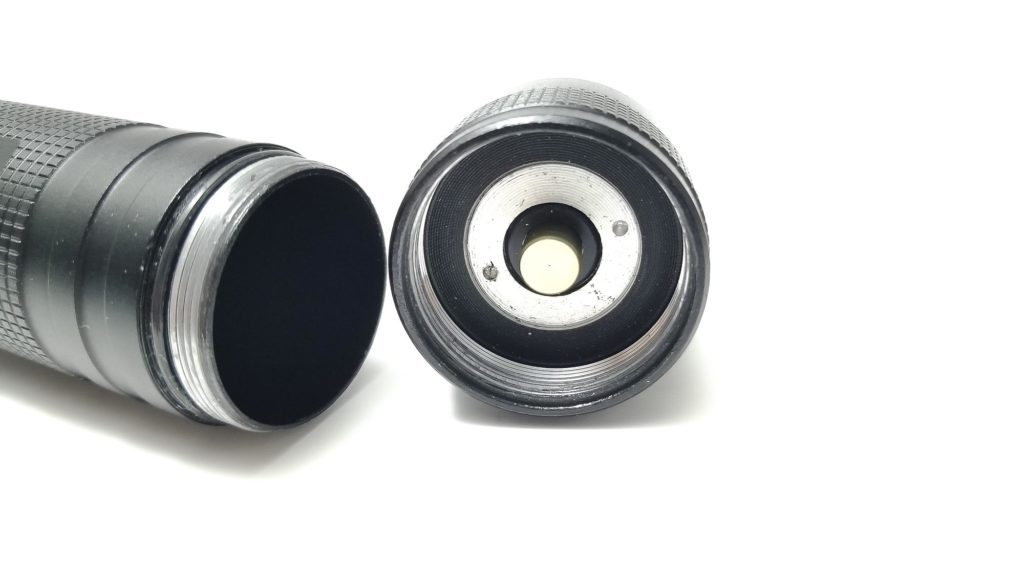

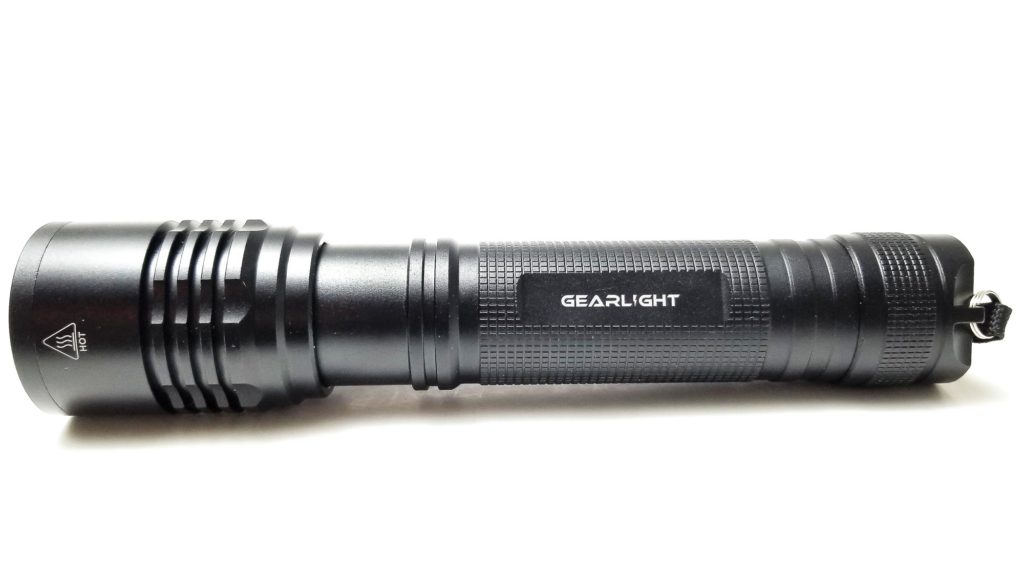
LED, Lens, Bezel, Beam, and Reflector
Like the smaller S1000, the S2000 has a fake LED under the lens, and this time it’s the other most-counterfeited Cree LED: the XM-L2. This is a 5050-size LED with dual bond wires. It’s mounted to an aluminum MCPCB, and it’s a decent fake and hard to tell (until you click it on). No tint is specified, but it sure looks very cool and more blue than white. I ran it through the Opple Lightmaster Pro on the High setting in flood mode and got 10,310K and 74.7 CRI. Duv was -0.0083, so way below the BBL. Yep, it’s got the blues, but hey, this isn’t an enthusiast light and most folks won’t care about that.
Since the S2000 is a zoomie, the light from the LED is focused by an aspheric lens mounted to the head. The LED stays in a fixed position, and the lens extends and retracts to change the beam shape from flood to spot. The aspheric lens is pretty large at 36.5 mm wide and made from plastic (keeping the costs down), and it was somewhat defect-free out of the box. There’s no lens protecting it and the bezel doesn’t offer much protection so it will get scratched up. The bezel is a non-crenulated aluminum deal that’s pretty light-duty.
Okay, the beam. It’s not terrible. There’s no ugly artifacts, and it has a very wide spill with the typical bat signal when the head’s fully extended. The LED-shaped (complete with dark areas where the bond wires attach to the LES) hotspot is pretty intense and made for surprisingly good throw (the numbers don’t lie on that…read on). There’s no spill when focused, so it’s kind of weird-looking if you aren’t used to it. The LED tint is very cool and completely washes out colors with blue-purple goodness.
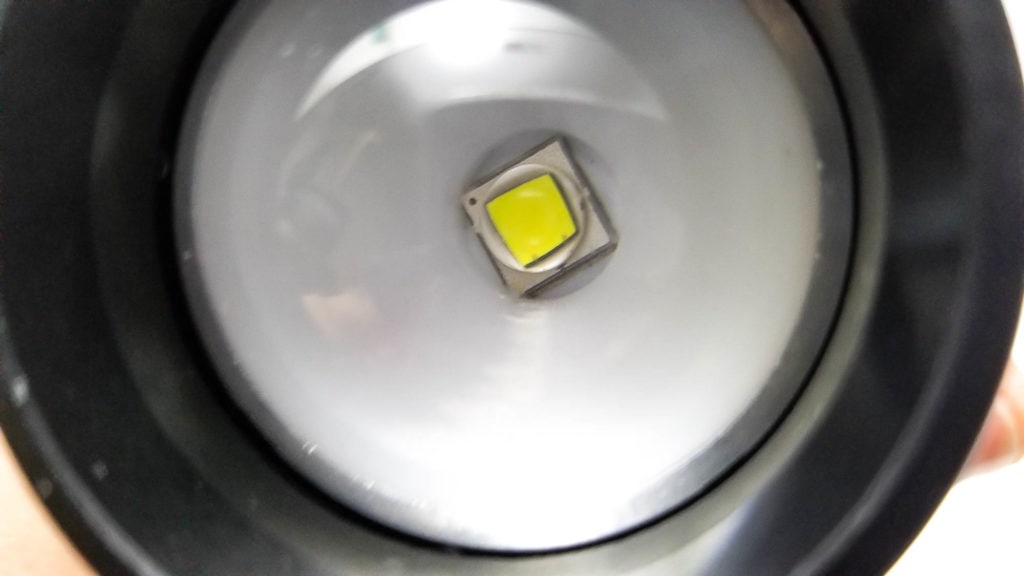
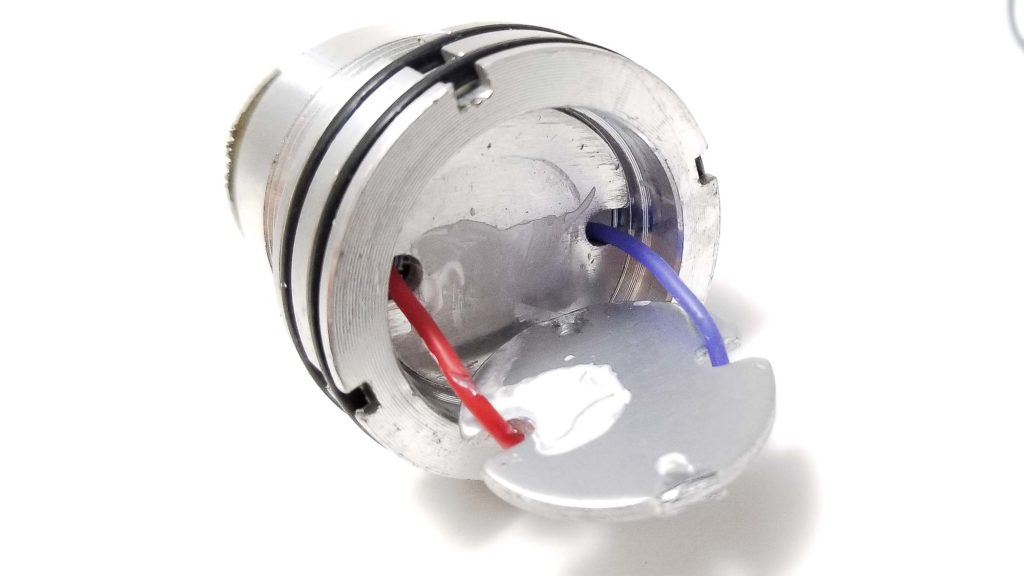
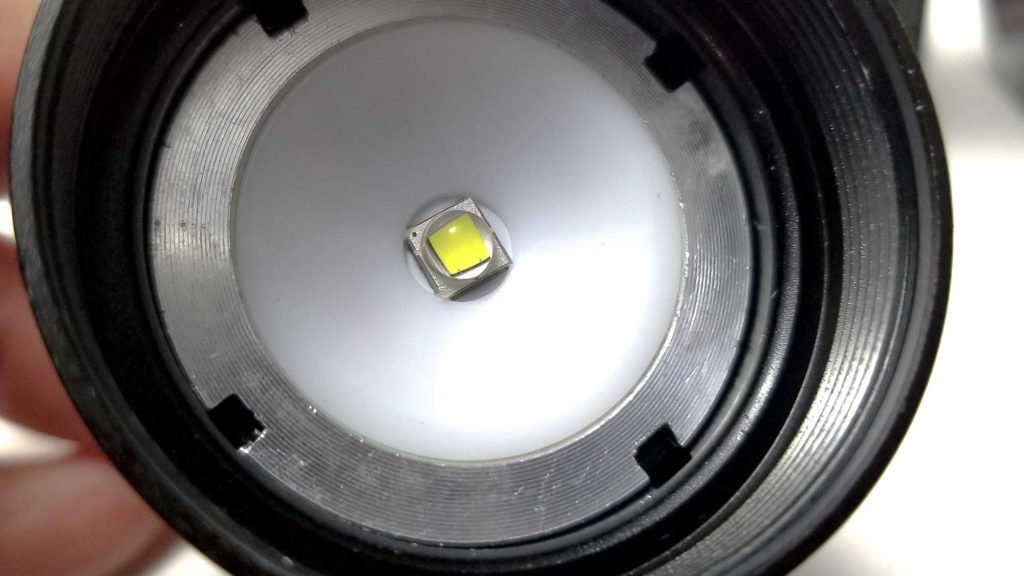
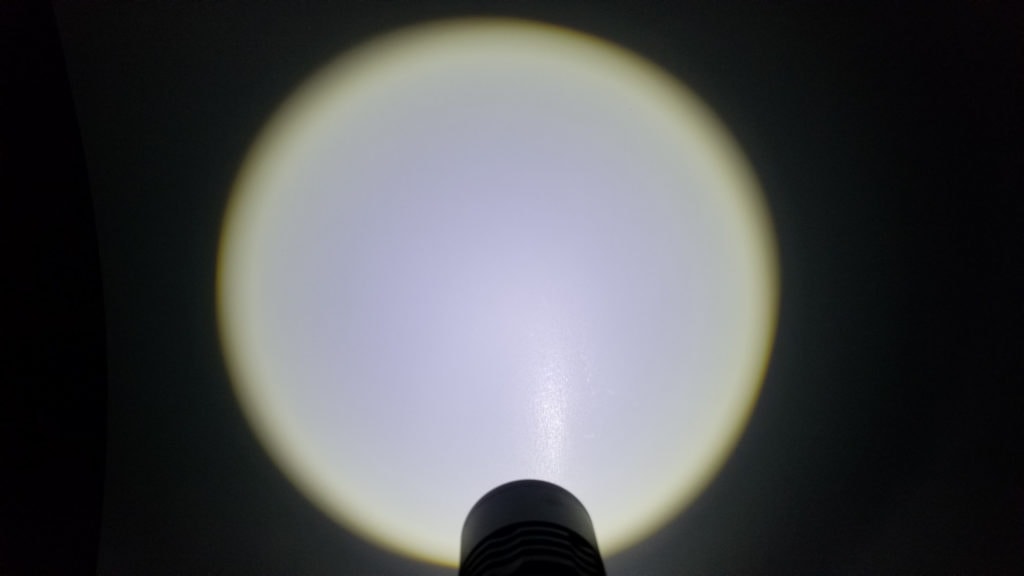
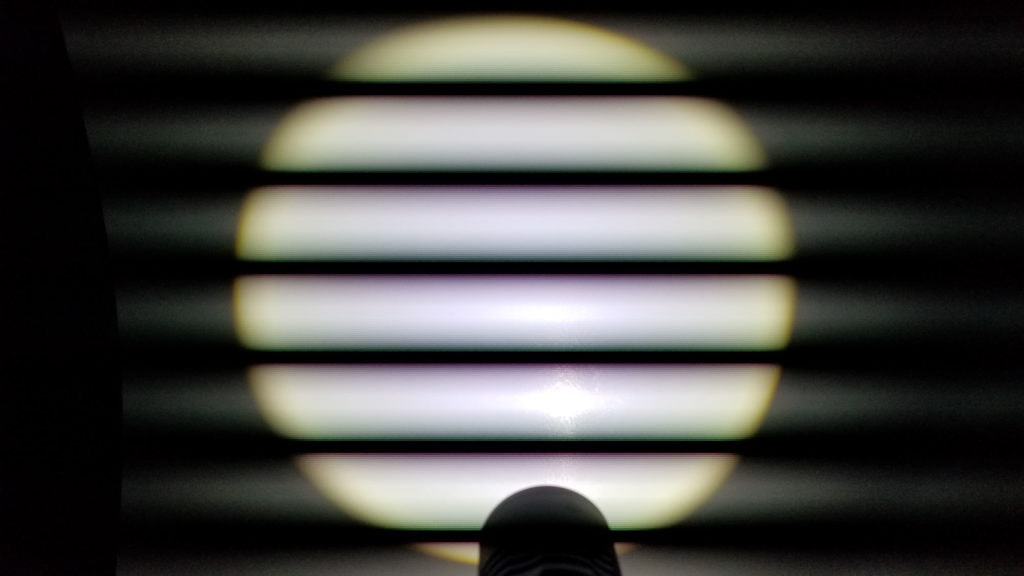
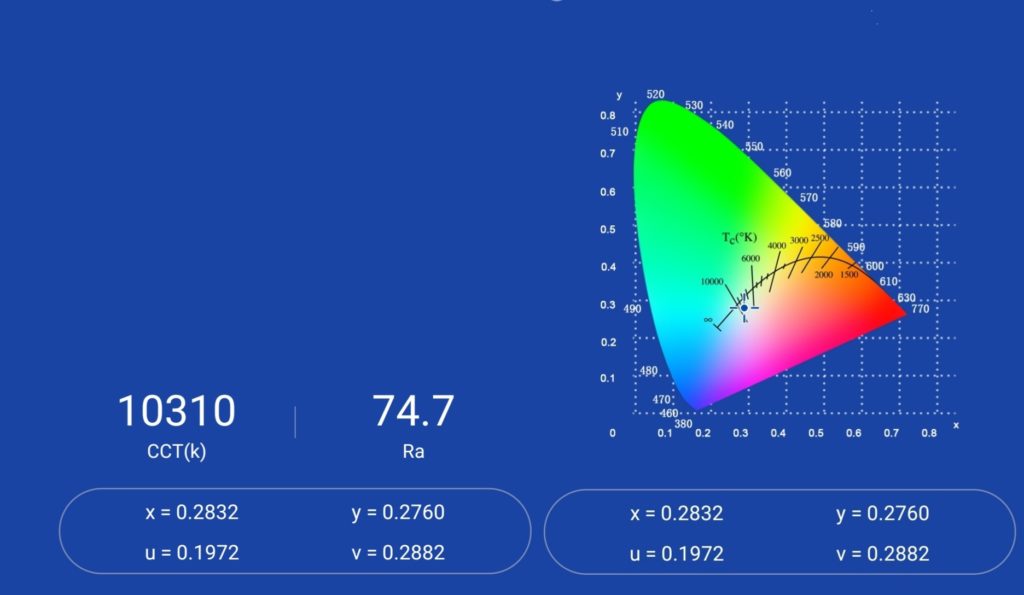
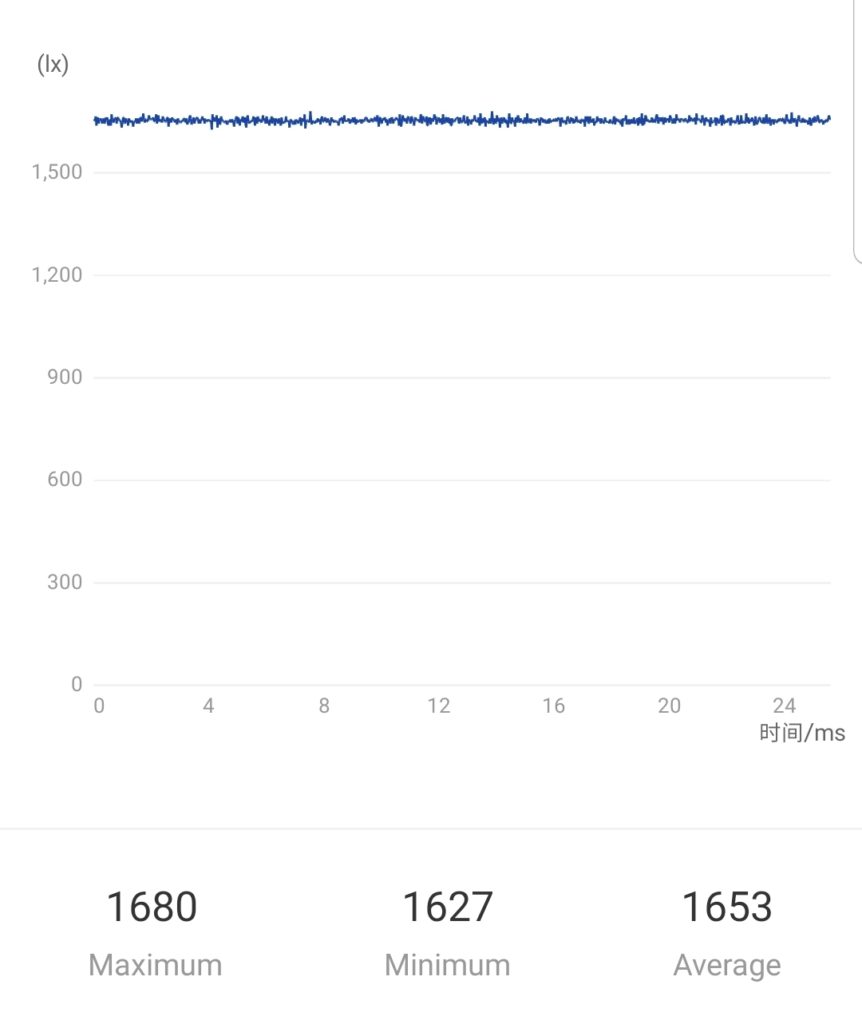
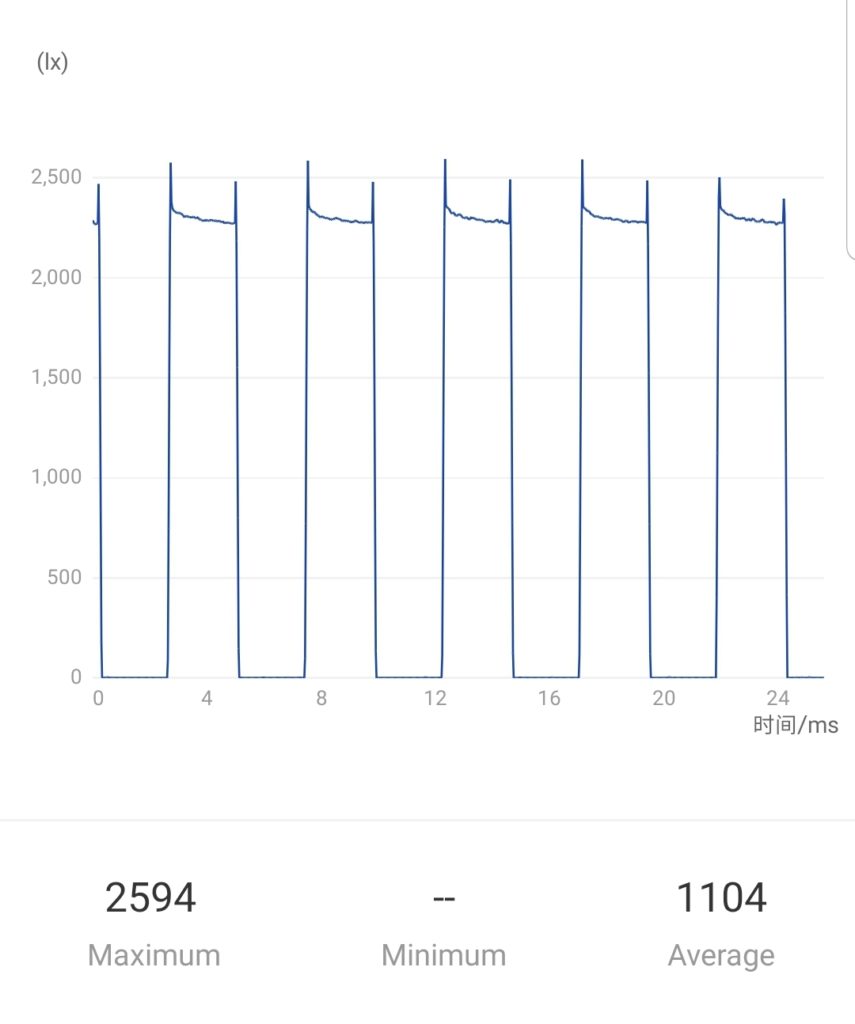
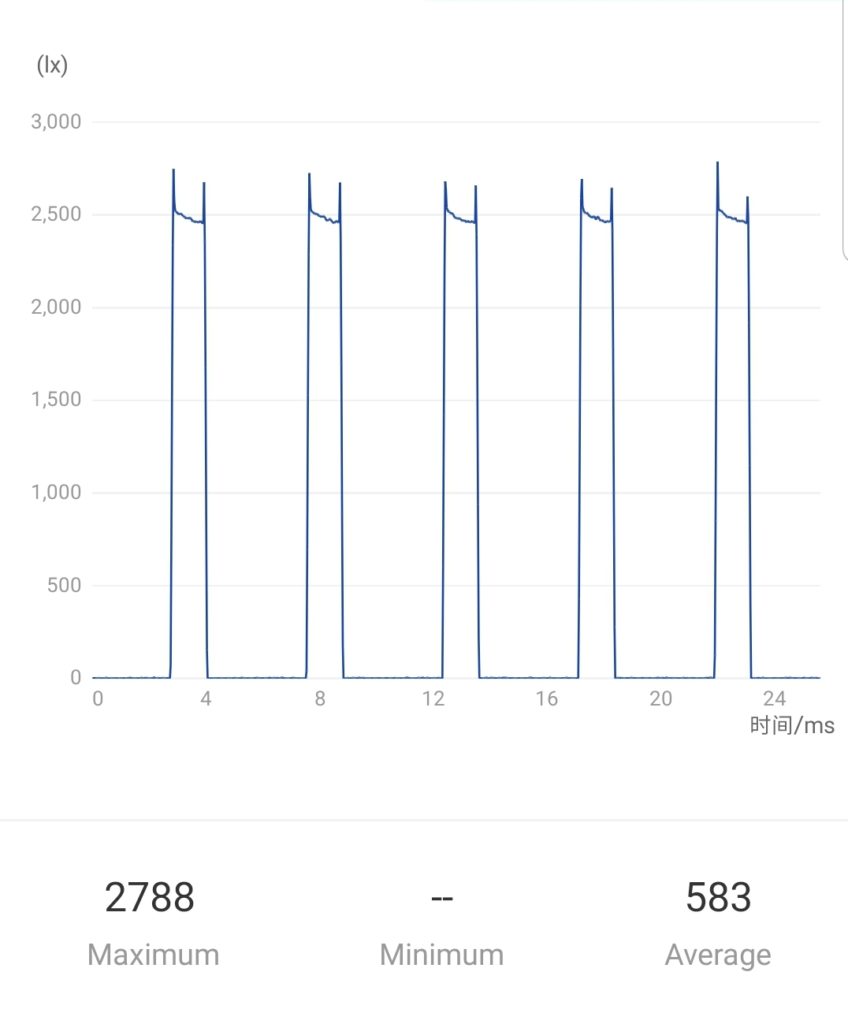
Dimensions and size comparison
Length:
- Length (head retracted): 19.5 cm / 7.66 inches
- Length (head extended): 21.5 cm / 8.46 inches
- Body: 3.53 cm / 1.38 inches
- Head diameter: 4.61 cm / 1.81 inches
Weight:
- Without batteries: 279.8 grams / 9.86 oz
- With 4xAA IKEA Ladda 2450 NiMH batteries: 400 grams / 14.10 oz
Flashlight competition & size comparison
I compared the S2000 to some similar-size (and not) flashlights.
Group 1 left to right: Astrolux FT02S, Wurkkos DL70, Gearlight S2000, Nightwatch NI03 Valkyrie, Acebeam L19
Group 2 left to right: Sofirn SP10 V3, Gearlight S2000, Thorfire C8
Group 3: Gearlight S2000, 3D Maglite
Group 4: Lumintop FWAA next to the S2000 cell carrier
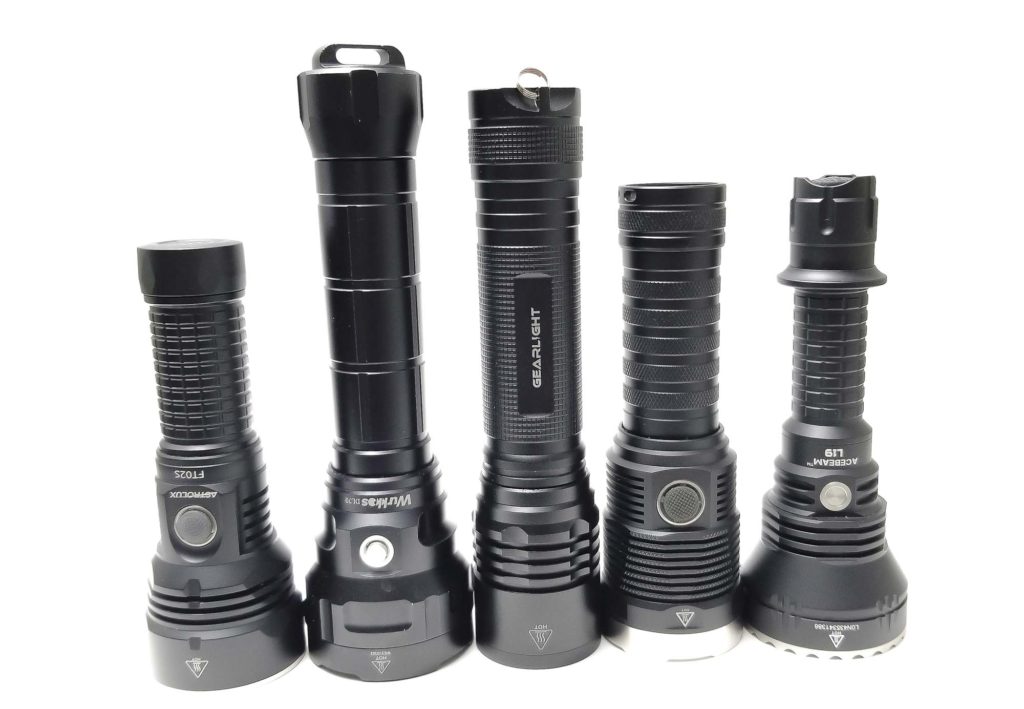
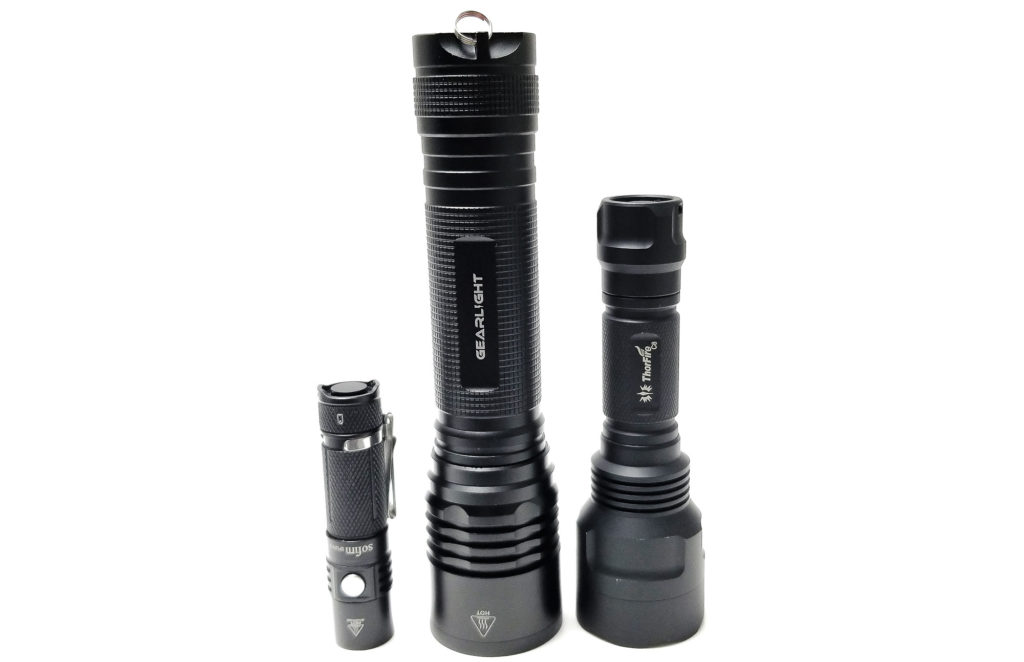
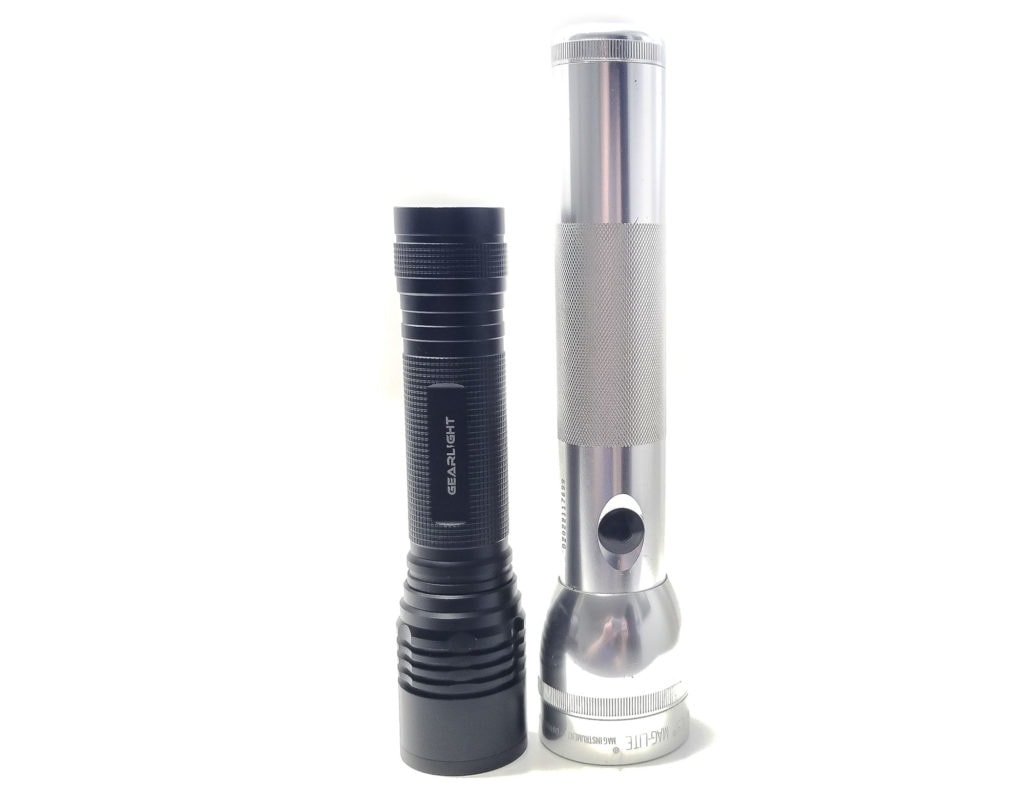
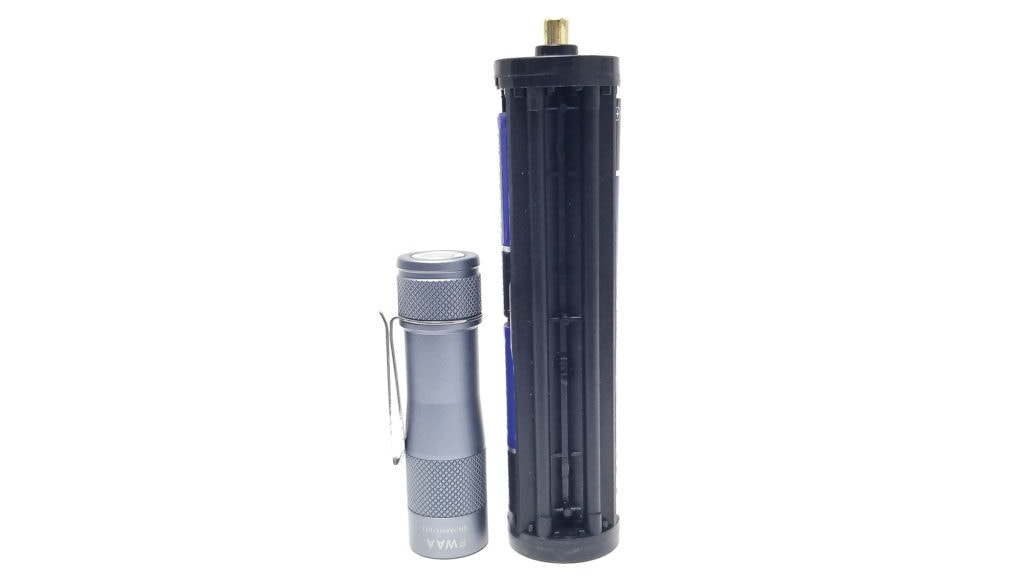
Driver & User Interface:
I was able to get a peak at the driver this time, and no surprise, it’s a typical cheap one with resistors, transistors, and an incognito MCU for the modes. It’s a little more advanced than the S1000 driver, which had no MCU, but that’s it. Brightness is controlled by PWM, with the high mode being direct drive. These cheap drivers are terrible for runtime and regulation, and as the batteries drain, the light output decreases proportionally.
The UI is exceedingly simple and not all that bad for a bare-bones flashlight UI. It’s 3 modes, with a Low, Medium, and High mode. What’s this? No blinkies? Yep, but there’s also no mode memory either. Fully click the switch to turn on, half-press to change modes, click to turn off. Told you it was easy.
Available modes: High, Medium, Low (in that order)
From OFF:
- Single click: Turns on
- Half-press: N/A
- Double click: N/A
From ON:
- Single click: Turns off
- Half-press: Switches modes H-M-L
- Double click: N/A
Mode memory:
- Nope. Always turns on in High.
Shortcuts:
- Nope
Low voltage warning:
- Nope.
Strobe/blinkies
- Nope
Lock-out mode:
- None. Not even mechanical.
PWM
- Yes. It’s easily visible with the naked eye in Low and Medium modes. I can’t quantify Hz figures, but using the Opple Lightmaster Pro’s “flicker” function, it gives an idea of the severity of the PWM duty-cycle in Low and Medium modes. I didn’t notice PWM in High mode, and that makes sense because it’s direct drive.
Additional info on the UI:
- This is a simple UI typical of cheap flashlights, and is identical to the S1000 (sans blinkies). Bad PWM (even worse than the S1000) and zero creature comforts like mode memory, visual LVP, or lockout. There’s no thermal management or timed stepdowns either. However, the mode spacing is decent, and to be fair, it doesn’t need temperature control. I would like to see a lower-Low mode though, and I don’t like how it turns on in High (good for tactical use lights…not this one).
Batteries & Charging
There’s a couple battery options for the S2000.
By default, it’s a 4 AA light, and can use either Alkaline, carbon-zinc, NiMH, or NiCad rechargeables. The batteries are housed in a carrier which arranges them in series for about 5.5 volts total on Alkalines.
It’s pretty sturdy and seems well-made, but I do not like this battery carrier.
Here’s why.
Although loading the batteries is easy enough, just slide in the rearmost battery and insert the forward battery last, removing them is not. You need a tool of some kind to pry up on the positive side of the leading battery and then lift it up and out. Once it’s out, you have to finagle the other battery about halfway up the slot and get your finger under the positive side and pry it up. It’s nearly impossible to get it out otherwise since there’s 2 tabs midway up the side of the carrier that keeps the batteries from popping out. This process is especially hard on batteries, and the wrapper near the positive end on my IKEA Ladda NiMH batteries was damaged and the wrapper lifted off the front of the cell after just two runtime tests. Lame. It begs the question of whether to sacrifice your not-so-cheap NiMH and just run Alkalines? Alkalines aren’t a great alternative, especially if you toss the S2000 in a toolbox, drawer, etc. and forget about it because Alkaline batteries can leak over time, and the resulting corrosion can ruin the light.
There’s no onboard charging, which is fine. When the batteries go flat, you can responsibly dispose of them, but if you use NiMH, you’ll need a separate charger, but there’s universal chargers that charge NiMH and li-ions around for about $15.
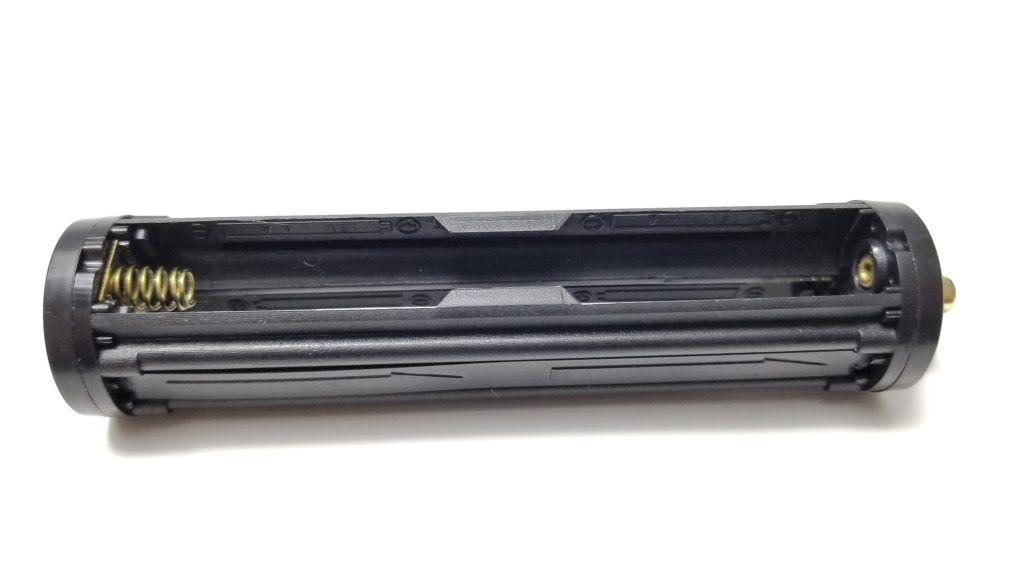
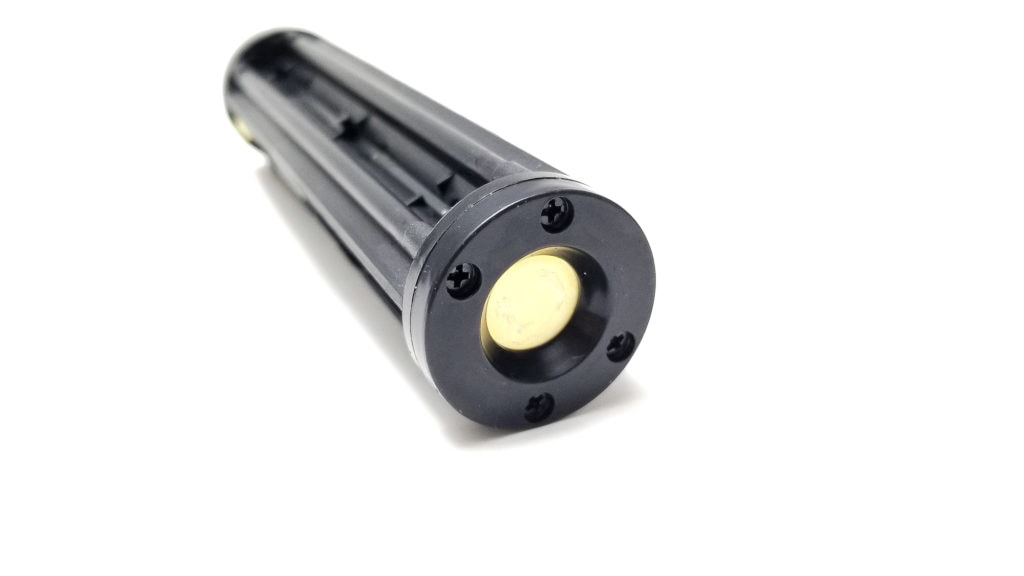
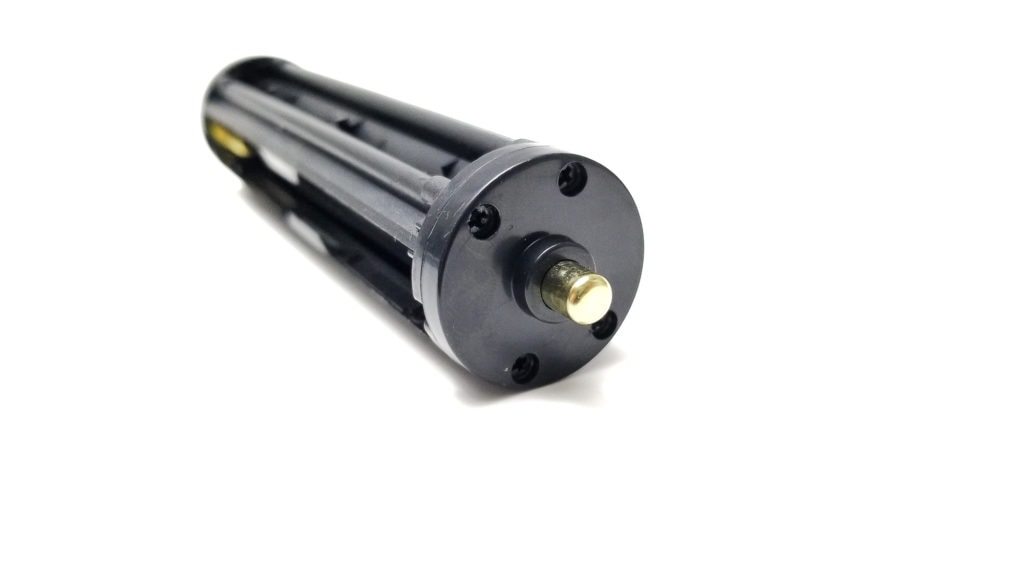
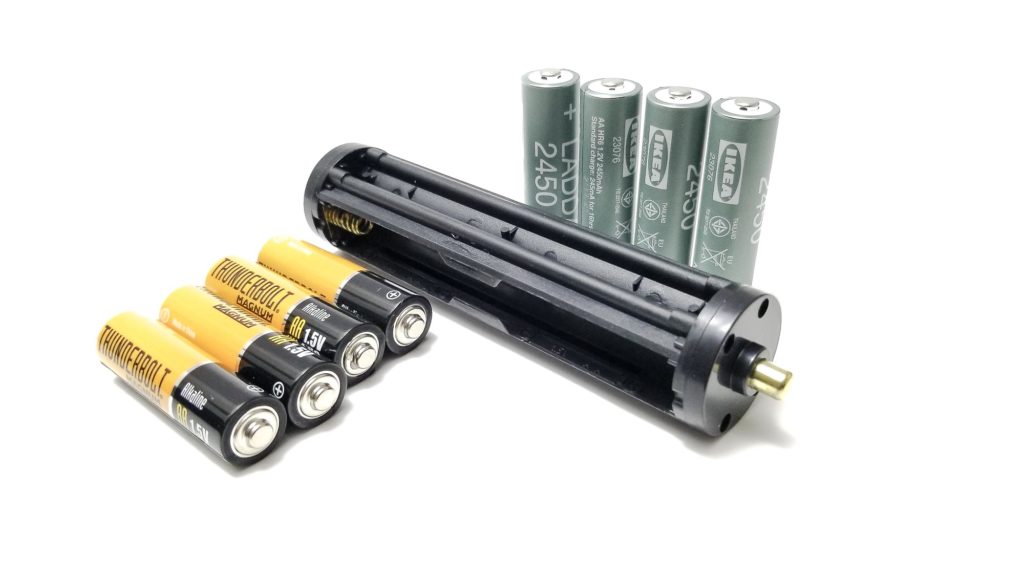
Performance test
Time to dispel the lies and bring the truth to light! Although the S2000 (like the S1000), don’t list Lumen or throw figures, that’s not because they don’t want to, but because they can’t since Amazon has rules about false advertising, which is great for consumers. Either way, it’s no secret that cheap flashlight manufacturers grossly over exaggerate specs to the point that 900,000 Lumens is no sweat for a single 18650.
I’ll be testing the S2000 the same as the S1000 with the same battery of tests that a more expensive flashlight would. I test output, runtime, and candela/throw. Lumens are measured in my 30 cm integrating sphere that’s been calibrated with several lights of known output including a Makkua-calibrated Convoy S2+. I use a Digi-Sense 20250-00 data logging lux meter for measurements. Zoomies lose a lot of light in the spot position (head fully extended), I ran these tests in the flood position (head fully retracted).
Since the S1000 can use Alkaline and NiMH batteries, I ran the S2000 using a fresh set of good quality AA Alkaline batteries and 4 fully charged IKEA Ladda 2450 mAh NiMH AAs.
| Mode | Amps at start | Specs | @turn on | @30 sec | @ 10 min |
|---|---|---|---|---|---|
| Low | Alkaline: 801 mA | ? | 243 lm | 232 lm | – |
| NiMH: 800 mA | ? | 249 lm | 249 lm | – | |
| Medium | Alkaline 1.62 A | ? | 415 lm | 407 lm | – |
| NiMH: 1.64 A | ? | 490 lm | 490 lm | – | |
| High | Alkaline: 3.01 A | ? | 855 lm | 664 lm | 332 lm |
| NiMH: 3.56 A | ? | 872 lm | 813 lm | 423 lm |
To give an idea of just how much light is lost in the spot position when the head is fully extended, I tested Low, Medium, and High using the NiMH batteries (at turn on):
- Low: 133 Lumens
- Medium: 183 Lumens
- High: 357 Lumens
Like with the S1000, a ton of light is being wasted here. When the zoom head is fully extended, it’s blocking light from escaping that the lens would otherwise capture and project. The only light being transmitted is what’s hitting the lens, and it’s only a small portion of the actual light emitted from the LED. This is why zoomies are not the best illumination tools and they’re shunned by enthusiasts.
Parasitic drain:
- None, it’s a clicky switch.
Runtime graph: Gearlight S2000 battery life
I tested the runtime in my 30 cm integrating sphere calibrated using several lights if known output including a Maukka S2+ with the Digi-Sense 20250-00 data logging luxmeter with a fresh set of good quality Alkaline AAs and 4 fully charged IKEA Ladda 2450 mAh NiMH. I only tested High mode with the head in the flood position since it produces the most light. Here we go!
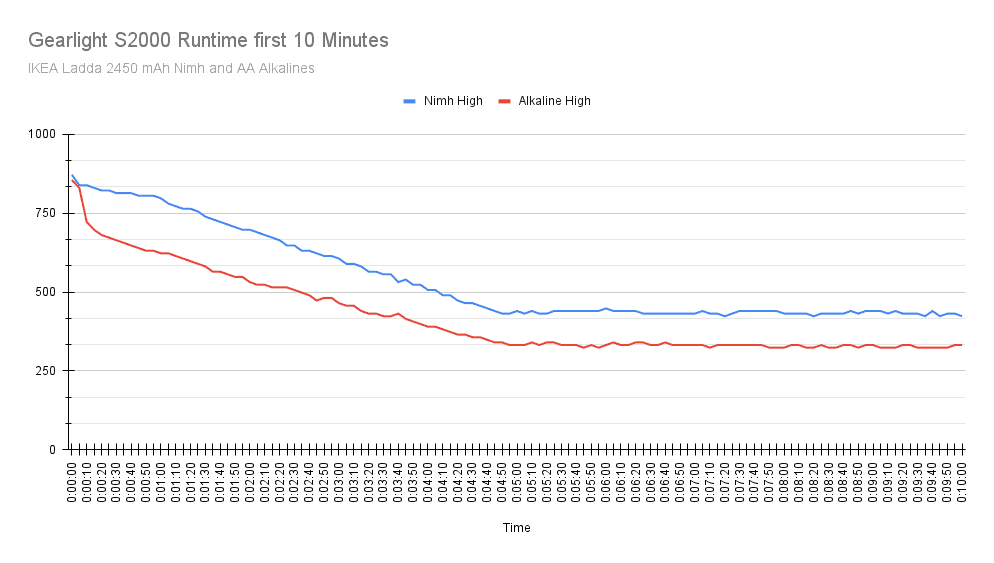
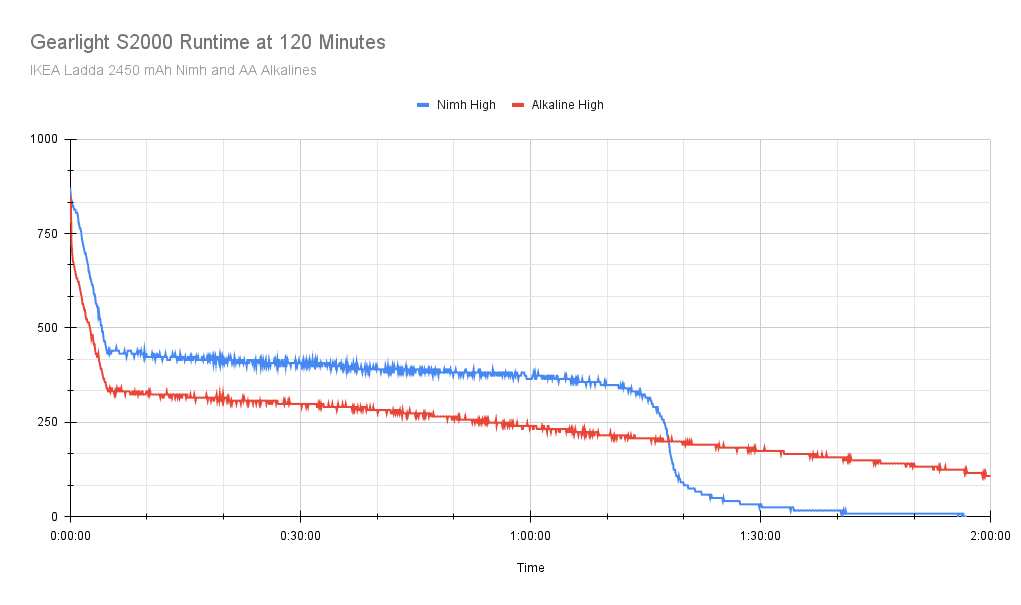
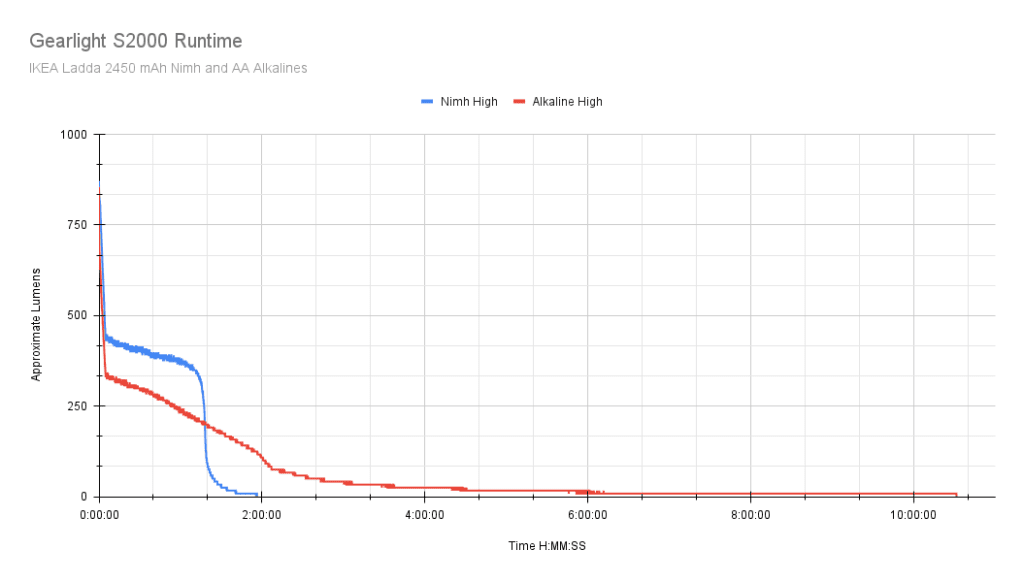
High on the IKEAs started at an impressive 871 Lumens, and not surprisingly, it didn’t last too long, but did better than I expected. By 30 seconds, it’s down to 813 Lumens, and kept dropping slowly over the next 30 minutes. By the 30 minute mark, the output is about 45% of the start, at 406 Lumens. Did it heat up? At 27 ambient, by 30 seconds the head is 33.3 C, and by 5 minutes it’s up to 41.1 C. At 10 minutes, it’s 43.6 C, but it started dropping from there. The output stayed around 370 Lumens from the 30 minute mark to about the 1 hour 5 minute mark, when the output really started dropping. By 1 hour 30 minutes it’s under 30 Lumens, and 26 minutes later, the light shuts down at 1 hour 56 minutes.
On the Alkalines (I splurged and got the best-cheapest high quality AAs I could find), which have a higher voltage initially than the NiMH, the output is still lower at start at 854 Lumens, and the output drops faster due to the Alkaline batteries lower current handling capabilities. By 15 seconds the difference is 130 Lumens, and by 30 seconds, the gap is 149. This levels out by the 1 hour 18 minute mark, as the Alkalines finally surpass the NiMH. When the NiMH give up, the Alkalines are still about 130 Lumens, and they kept going until the 10 hour 31 minute mark when I ended the test because the output had dropped off the luxmeter scale. I have no doubt the S2000 would have kept running until the batteries were well under 1 volt. The light didn’t heat up as much as the NiMH test, tying about 4-5 C cooler throughout.
What’d we learn here? This is typical of an unregulated, direct drive flashlight driver. As the batteries drain, the light dims until it gets so dim that you replace the batteries. There’s no thermal regulation either, and I don’t think it needs it.
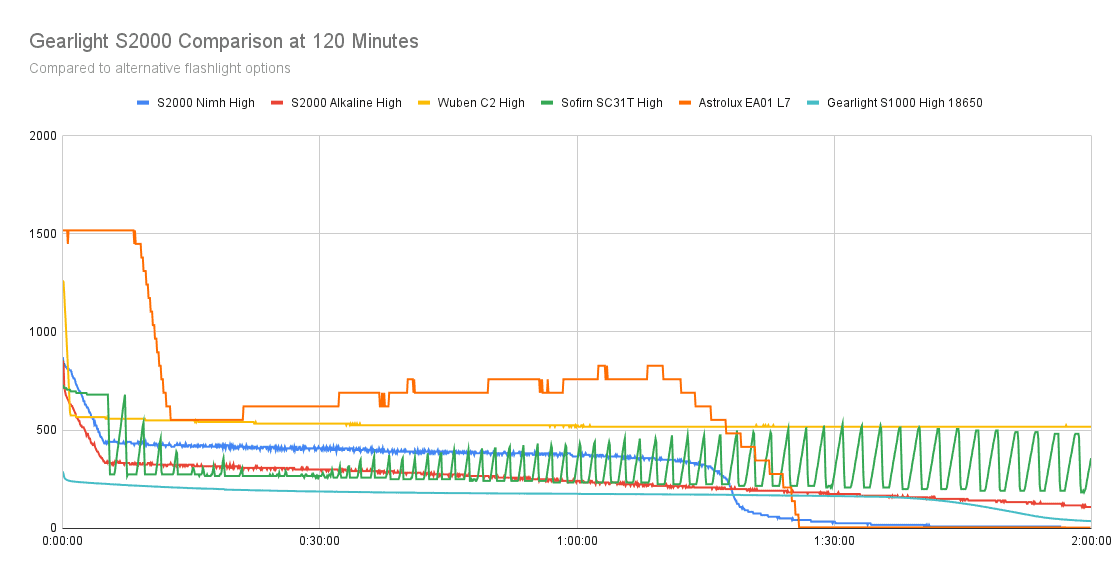
For yucks, I threw in the High mode runtime graphs of several affordable competing flashlights, the Sofirn SC31T, Wuben C2, Astrolux EA01, and I threw in the S1000 for fun. The Wuben C2 has a proper, constant current buck driver, so the runtimes are amazing, while the SC31T and EA01 are both FET drivers and unregulated. These lights are all about $30-$40 (on sale), the Sofirn and Wuben include batteries and have straightforward UIs. The Astrolux is the hotrod here, with a FET driver and a pretty advanced UI, but it represents the pinnacle of performance-per-dollar of this group. Like the S1000, although the S2000 is cheap, there are better options for only a little more money.
Throw numbers:
I measured the throw with the Uni-T UT383S luxmeter indoors at 5 meters. I took readings with the IKEA Ladda NiMH AA and fresh Alkalines.Readings recorded at 30 seconds. Since this is a zoomie, I measured the throw in the spot position.
| Mode | Specs | Candela measured | Meters | Yards |
|---|---|---|---|---|
| Low | ? | Alkaline: 16,275 cd | 255 | 279 |
| – | – | NiMH: 18,550 cd | 272 | 298 |
| Medium | ? | Alkaline:23,775 cd | 308 | 337 |
| – | – | NiMH: 31,975 cd | 358 | 391 |
| High | ? | Alkaline: 44,625 cd | 422 | 462 |
| – | – | NiMH: 62,575 cd | 500 | 547 |
Well color me impressed! There are times in life when one must accept the fact they’re wrong, and this is one. Honestly, I wasn’t expecting 500 m of throw from a zoomie costing just $22. To put it in perspective, the S2000 is beating the $70 Thrunite TC20 V2, $100 Fenix TK16 V2, $260 Thrunite TN50, and $90 Speras E3. However, this doesn’t tell the whole picture, because retracting the head to flood mode absolutely kills the throw: On High (at turn-on), the Alkalines are making 1775 cd, the NiMH 2100 cd.
Beamshots
The fence is 95 meters away.
The end of the hallway is about 12 meters.
I compared a bunch of cheap zoomies and some traditional flashlights from the runtime comparison. I included some cheap C8 style lights also, typical of what you can get for about $30 from Convoy, Sofirn, or Astrolux. Pictures taken with the same camera settings. Zoomies behave a bit like an LEP, with no side illumination (spill) and all Bat Signal (hotspot). This limits usability quite a bit since you can’t see what’s in front of you, and the ‘Bat Signal” shape of the hotspot can be a bit distracting, especially if you’re used to a traditional hotspot. The S2000 throws pretty good, and has a lot of flood, but compared to a cheap C8, we can see how much the zoomie design gives up to a traditional reflector or optic like the Astrolux EA01.
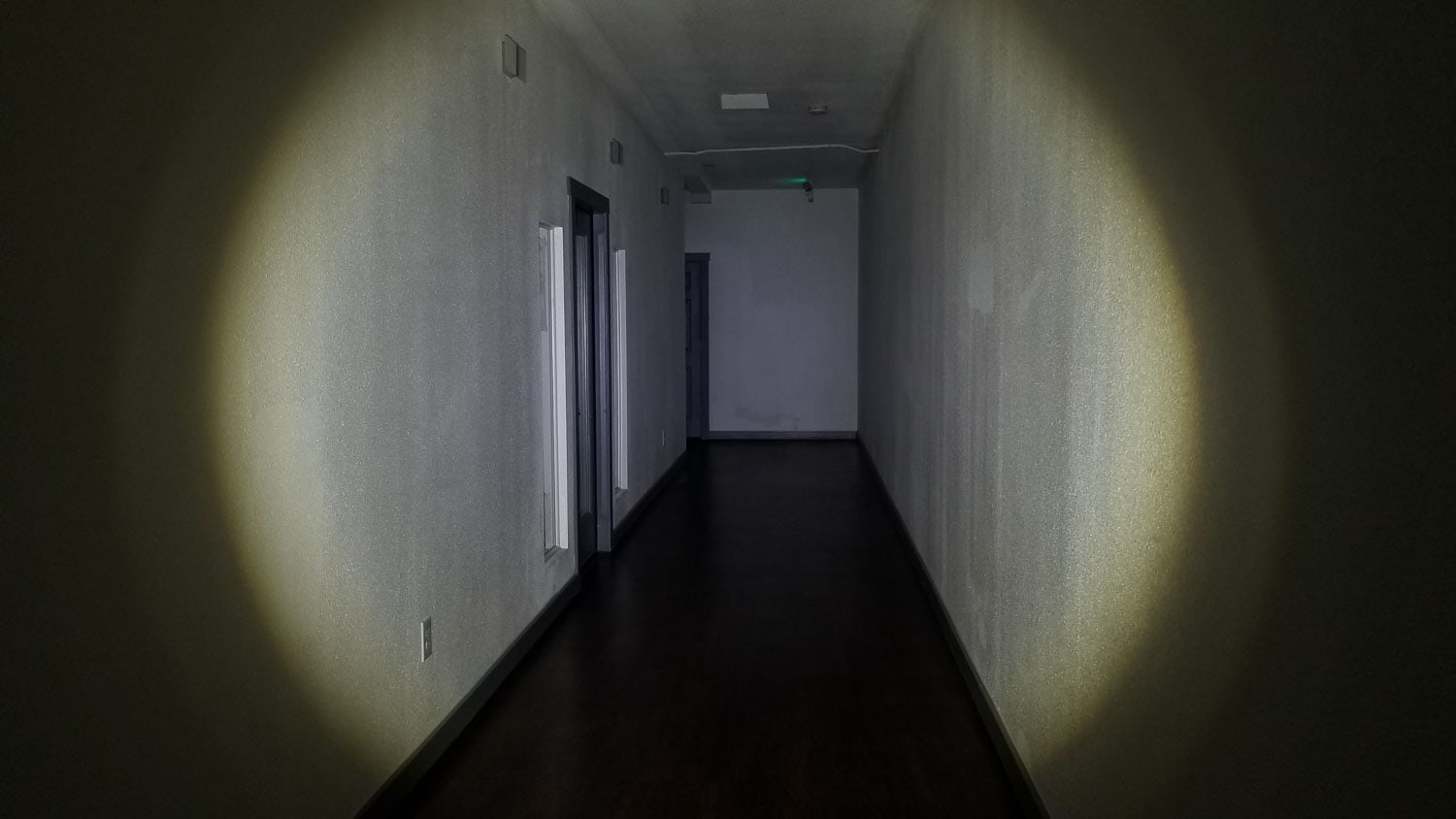

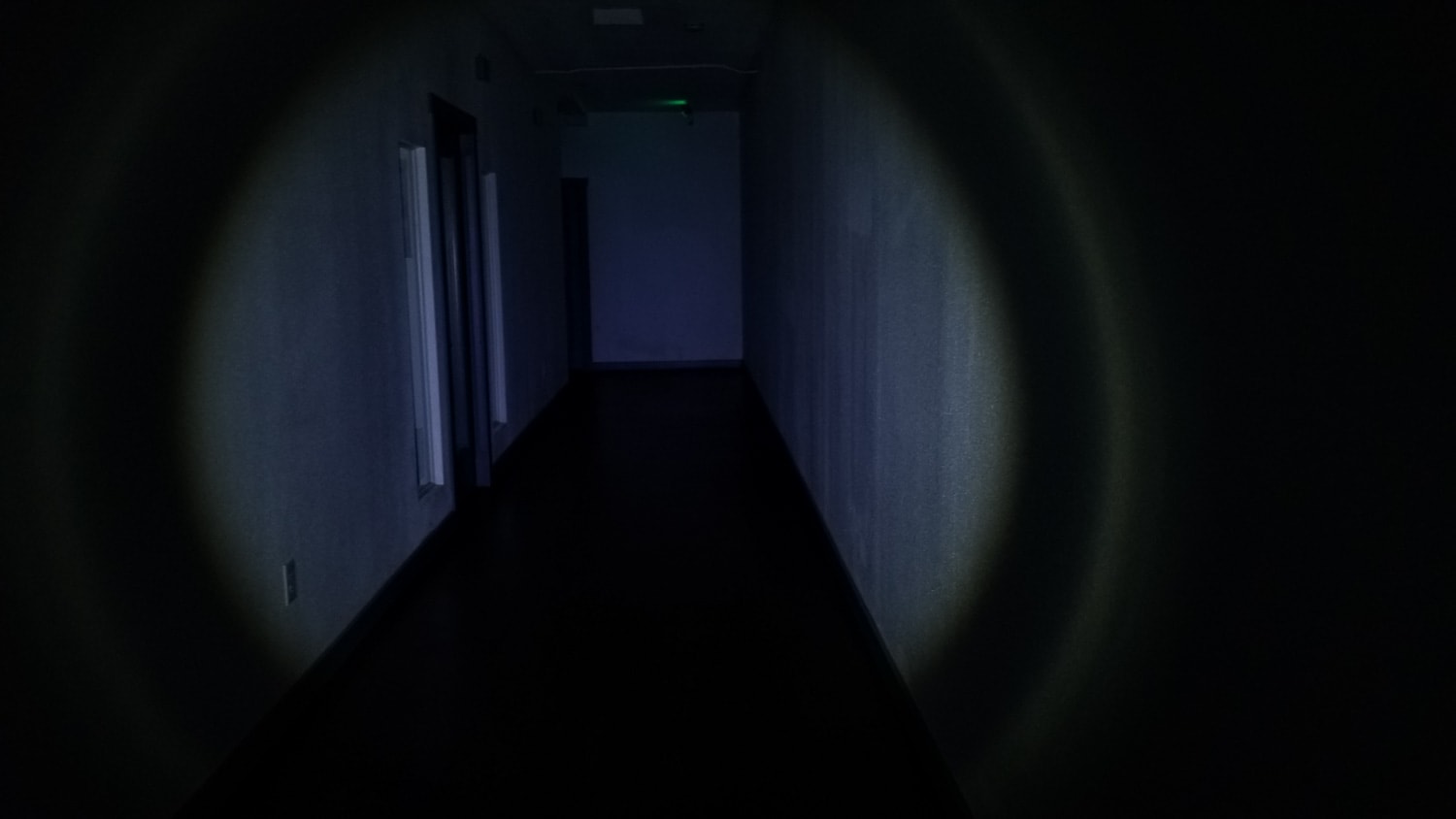
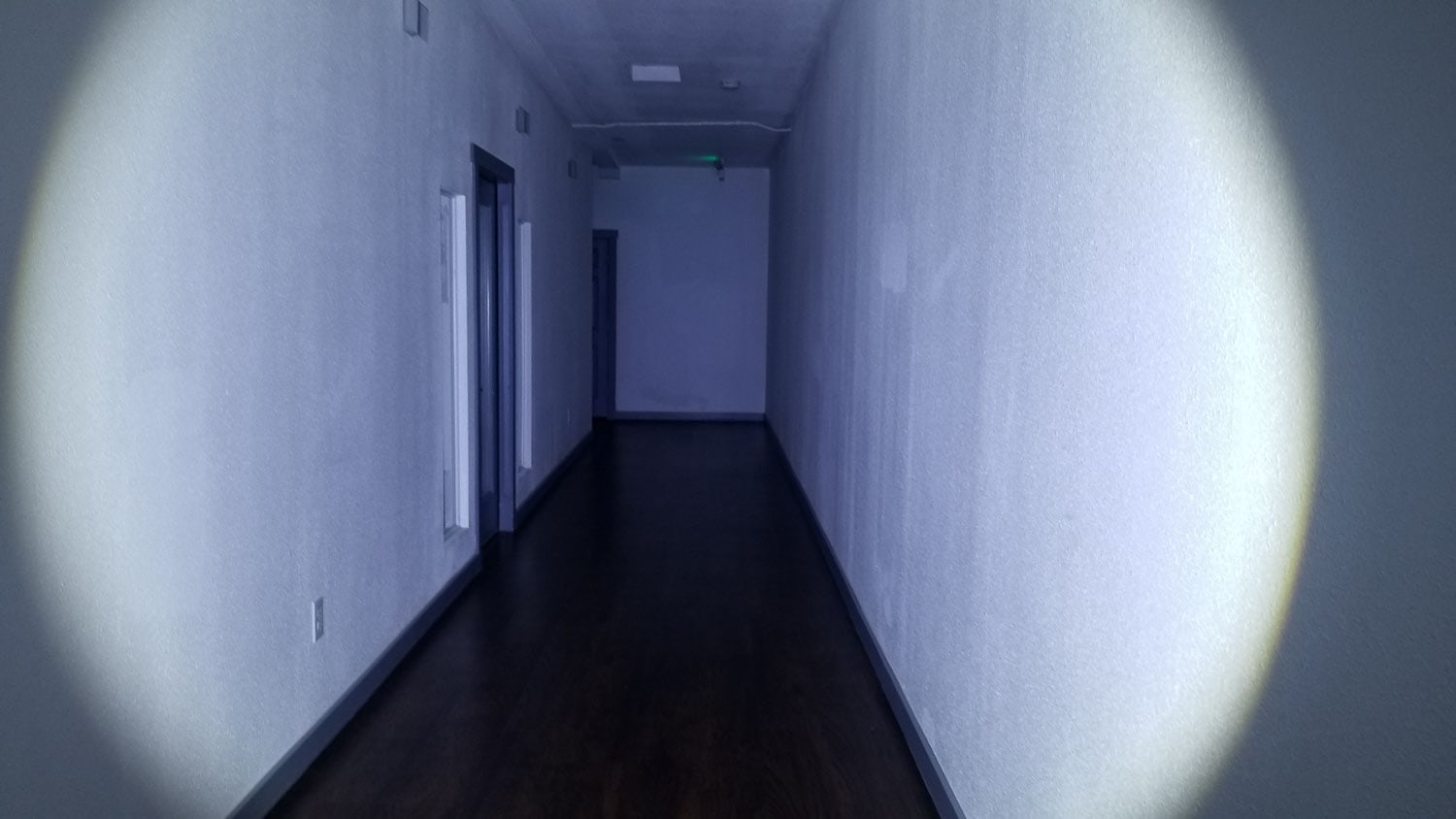
Same flashlights, but now with their tightest spot (zoomed in)
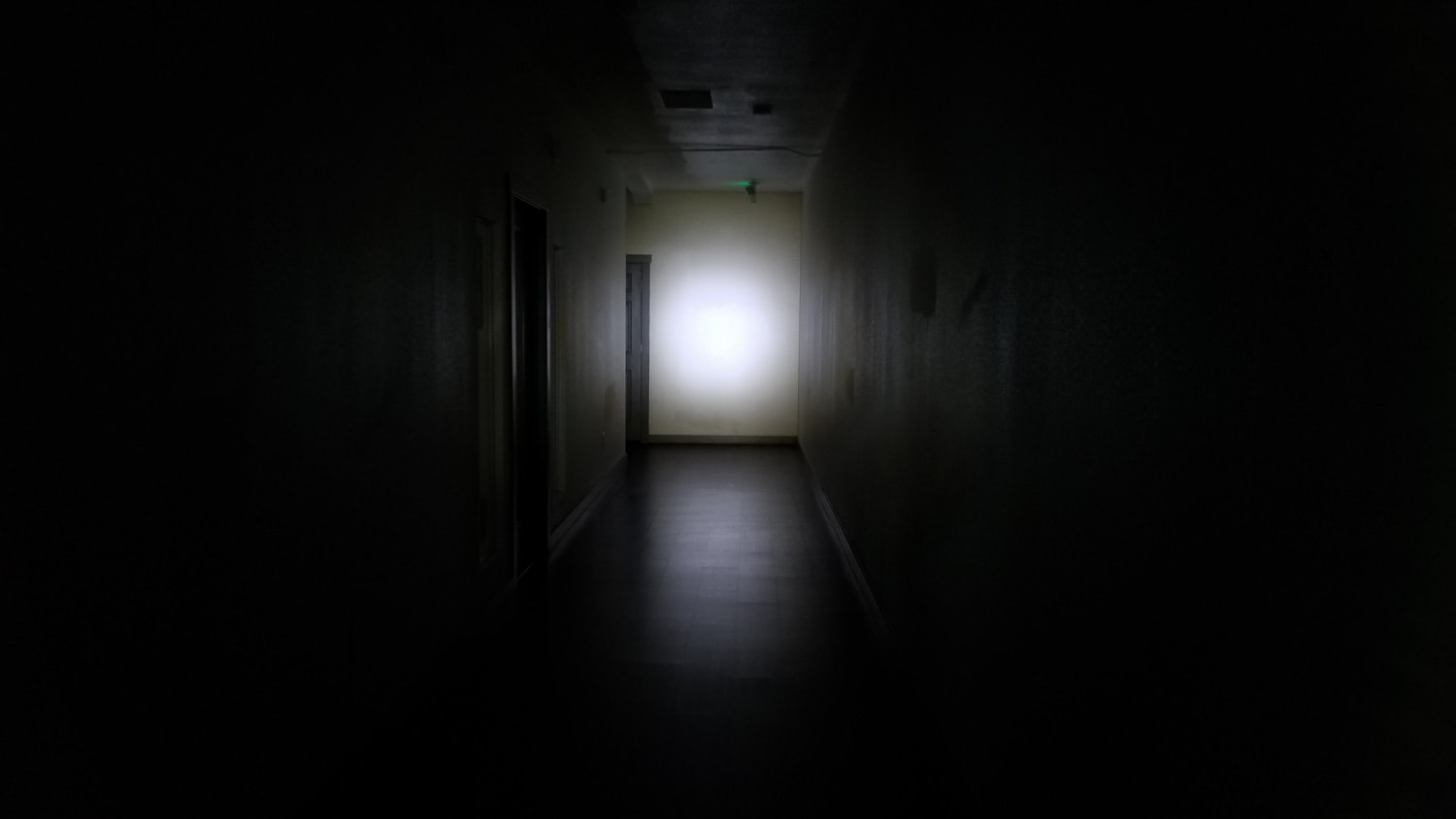
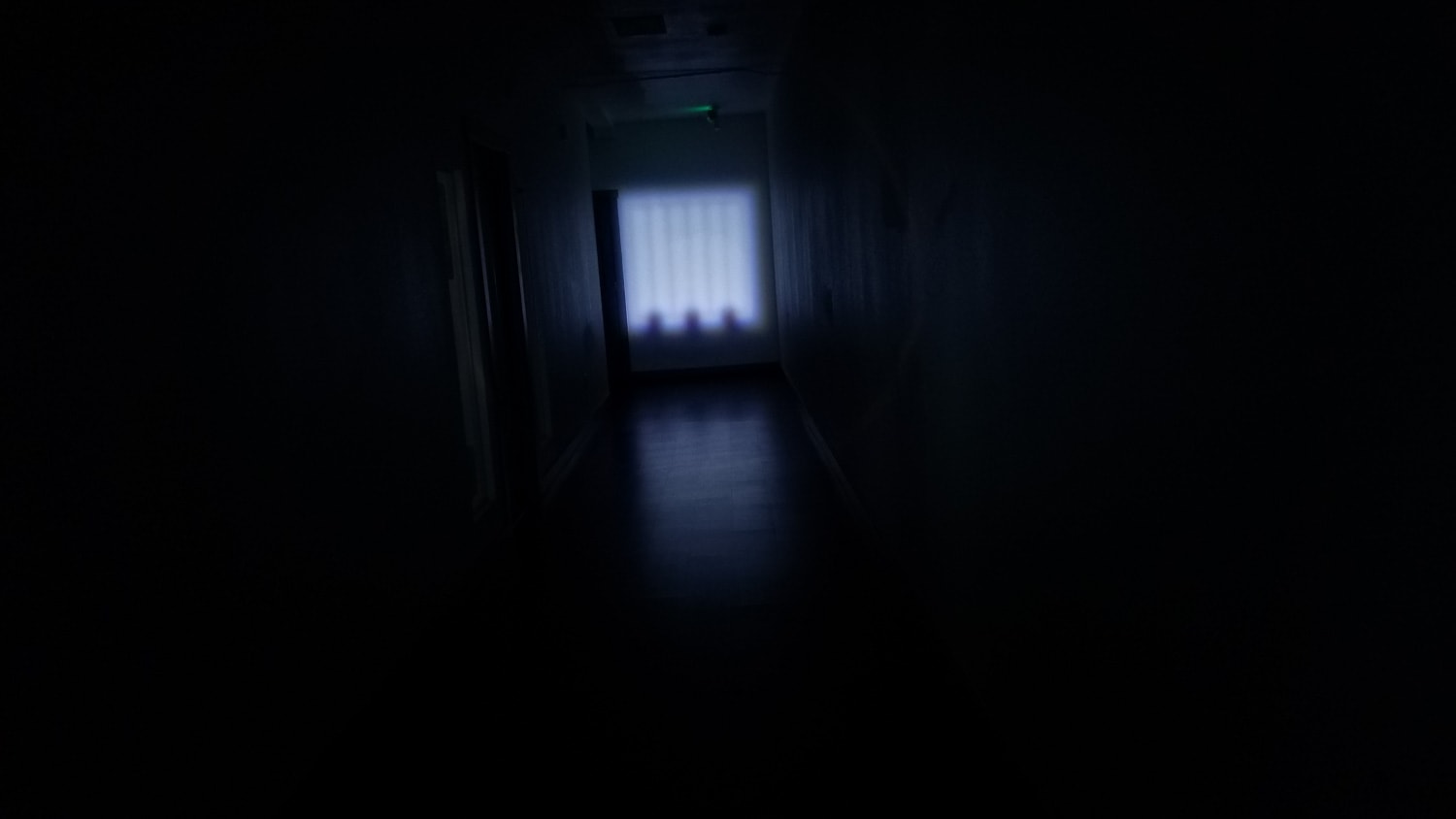
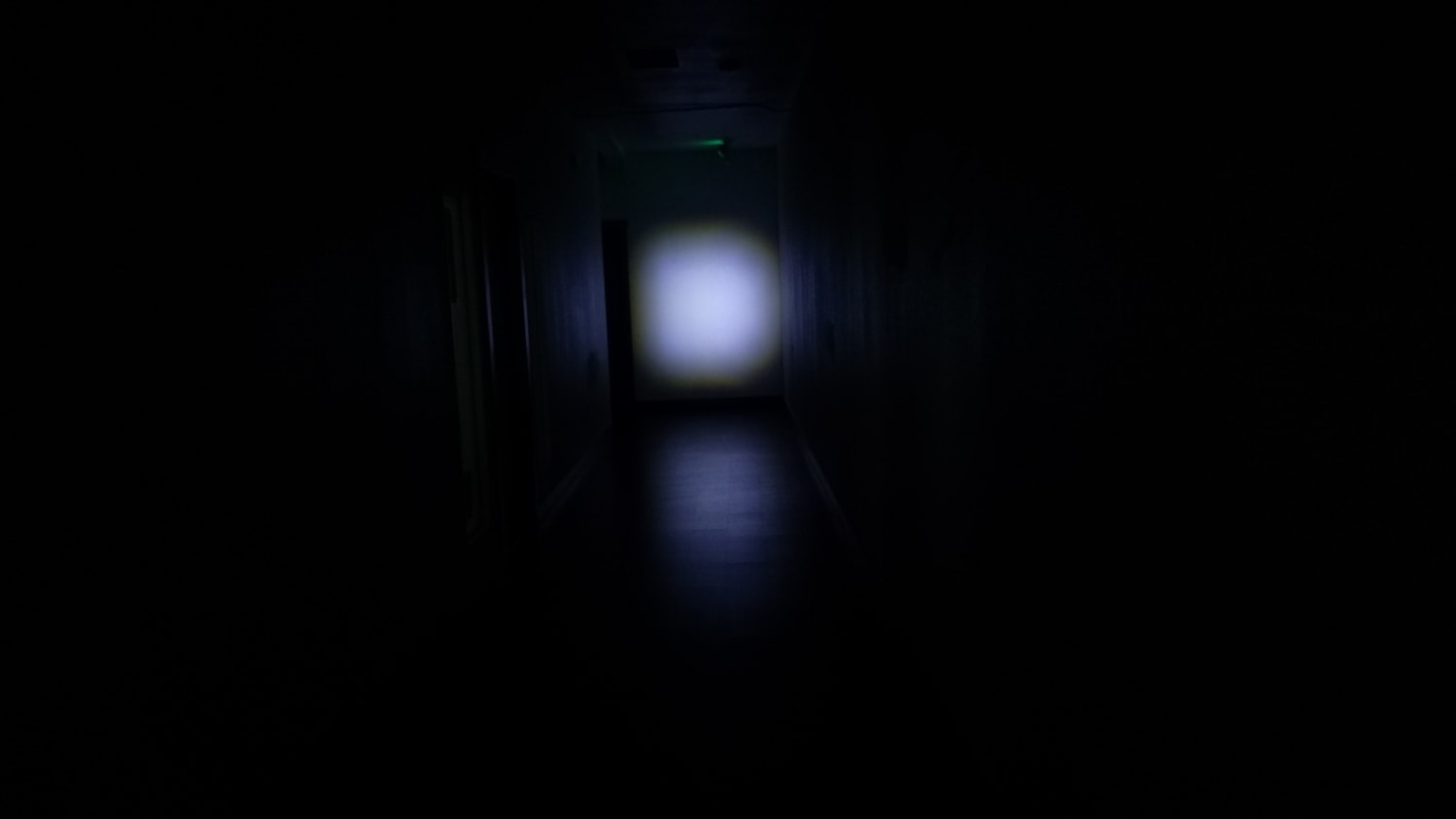
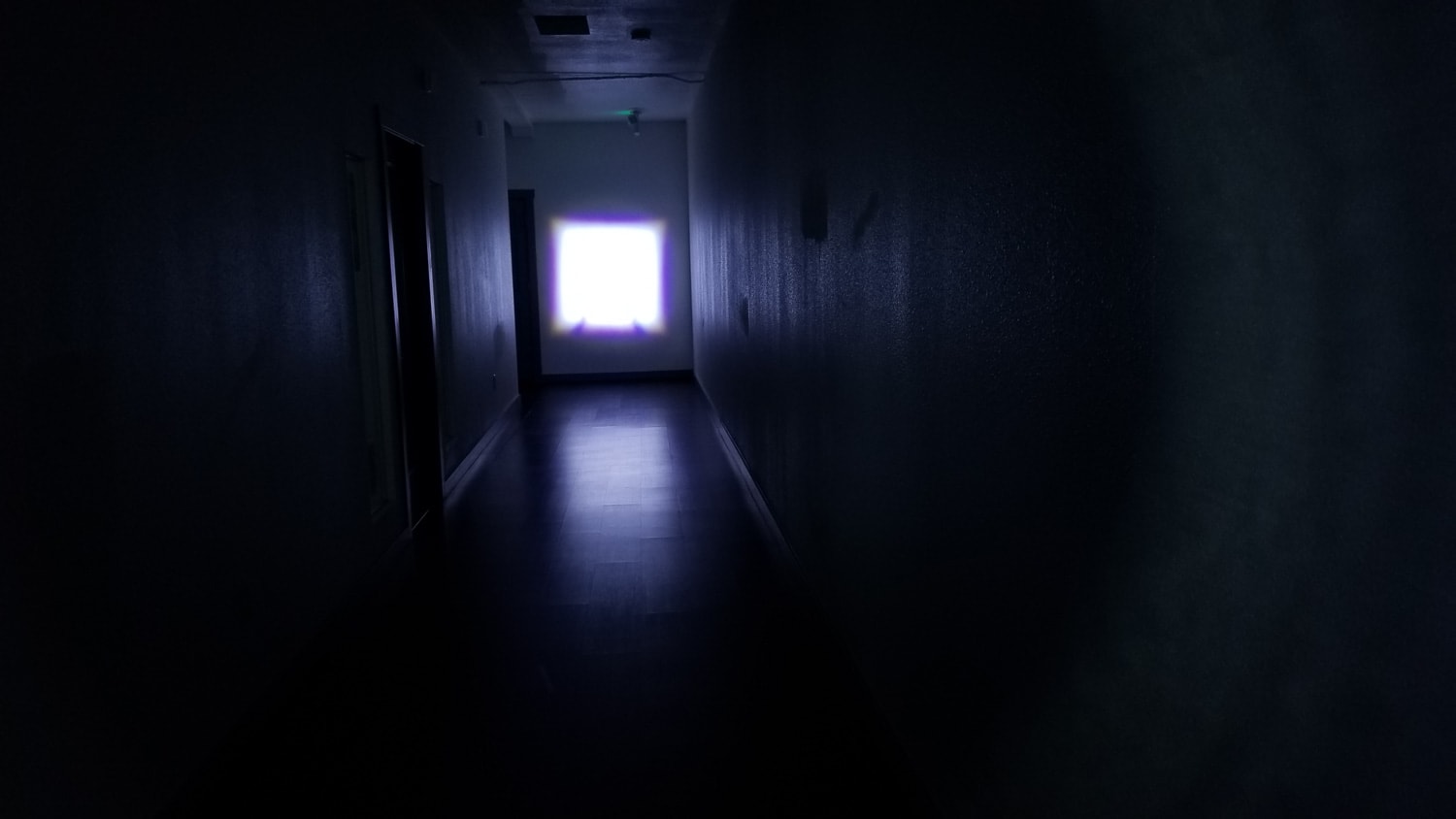
40 meters:

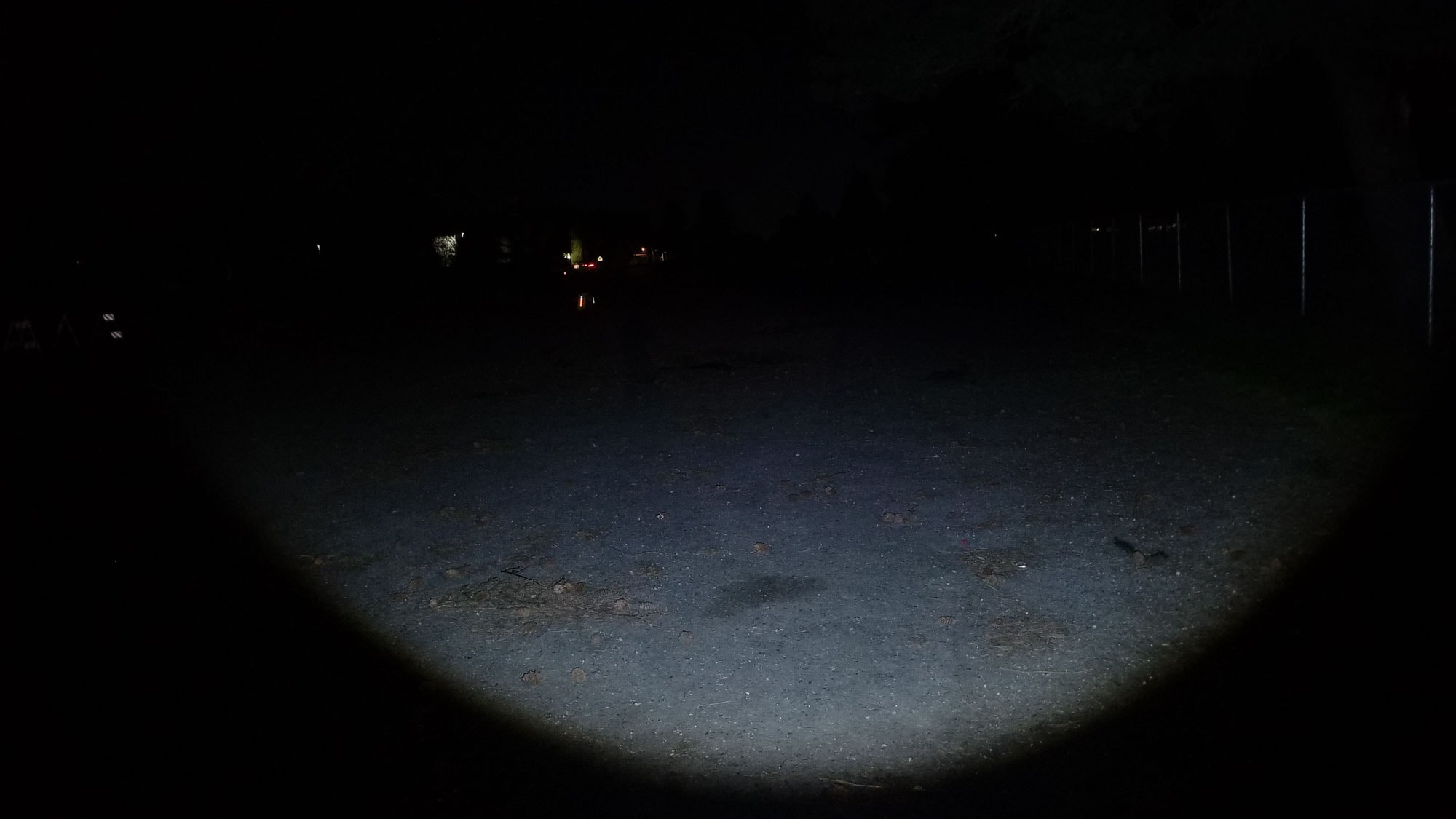
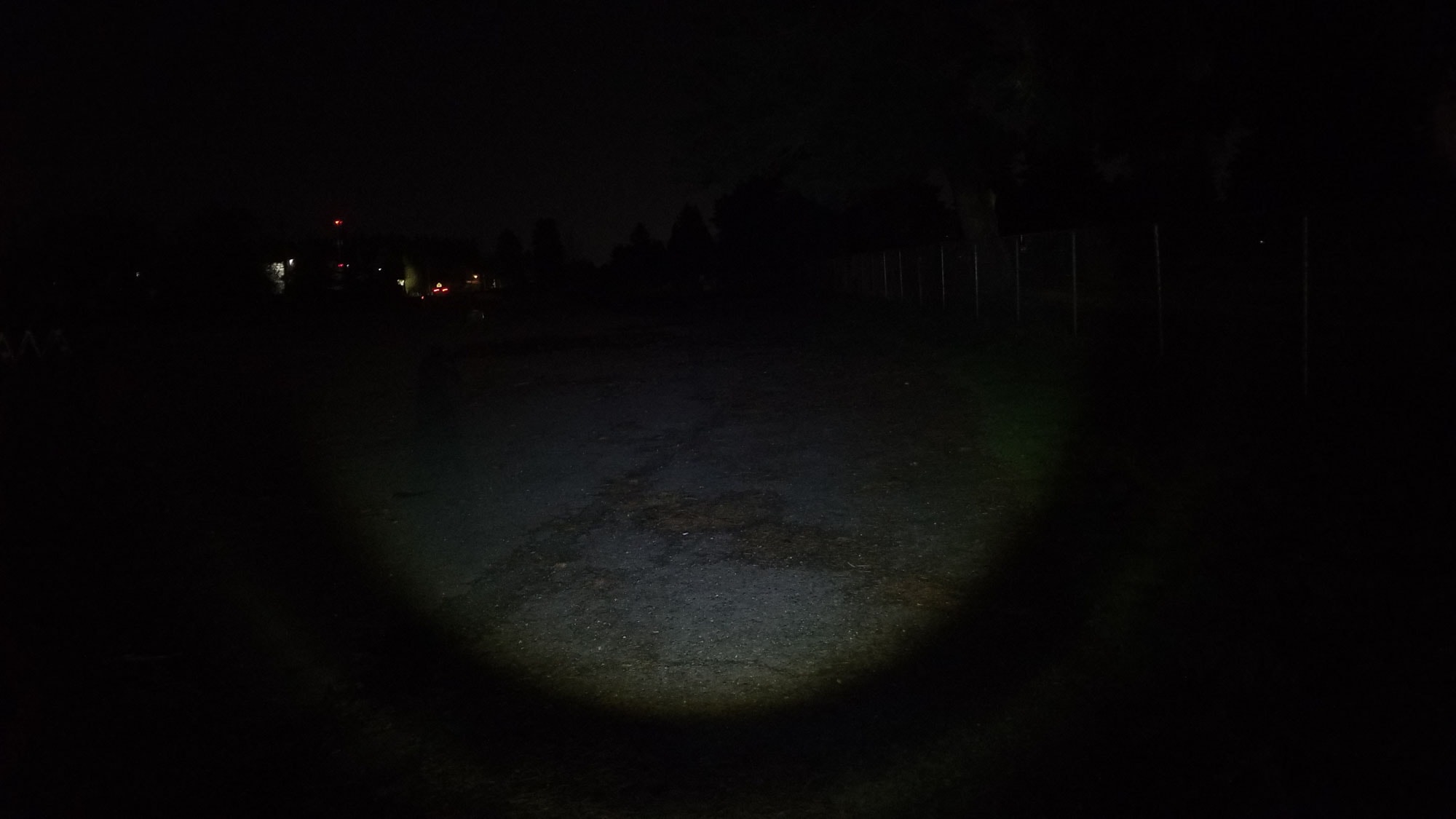

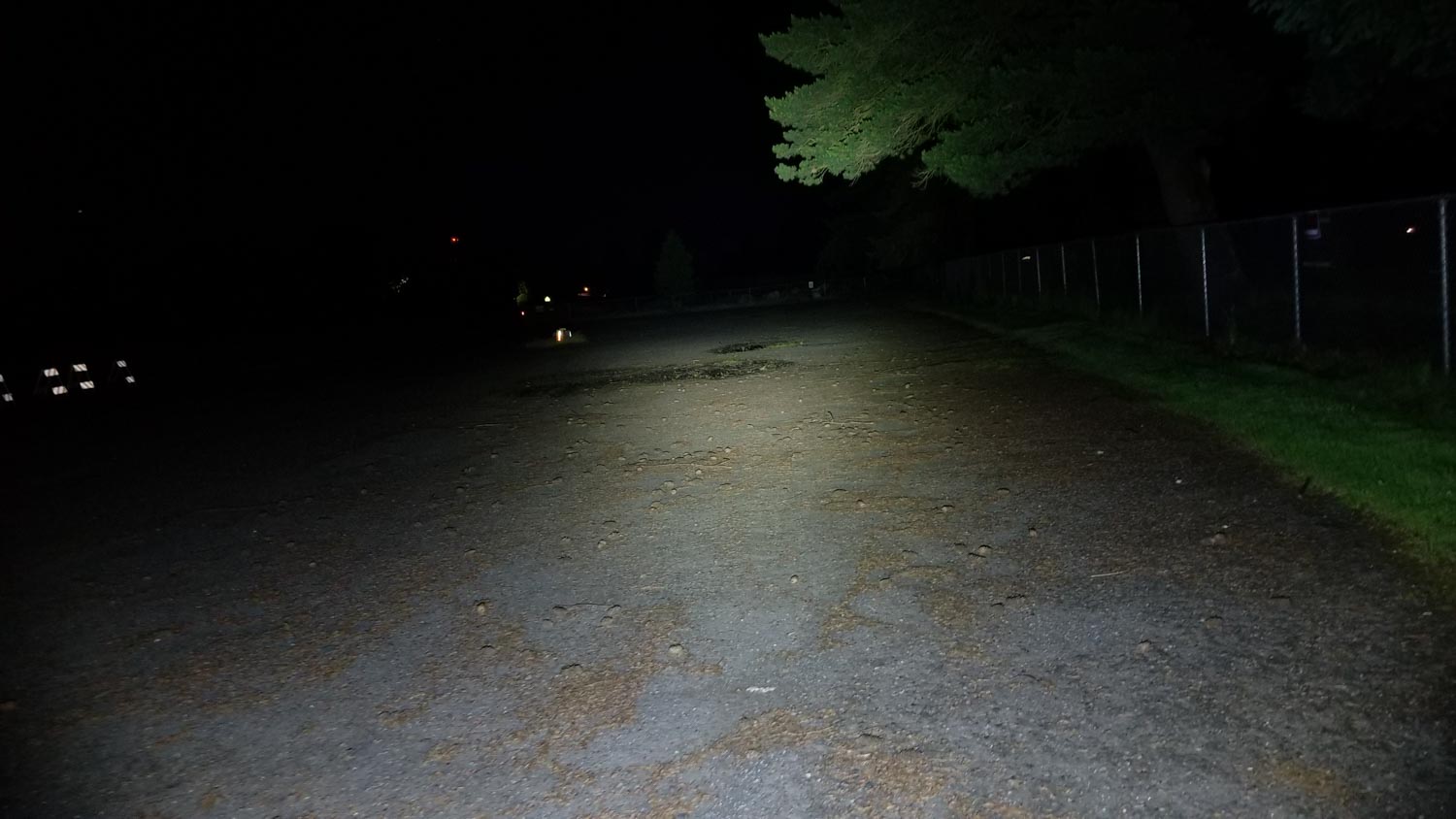

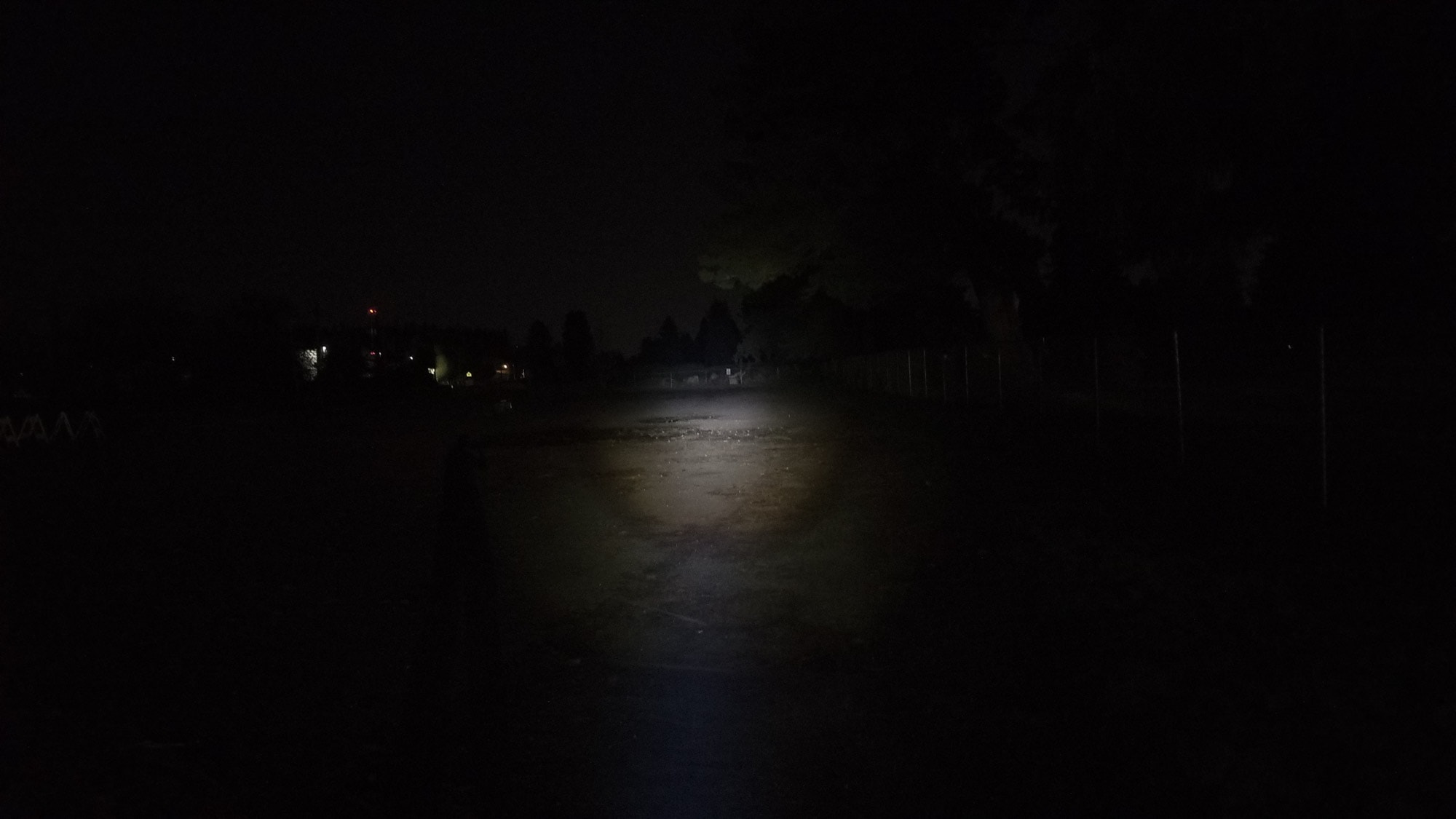
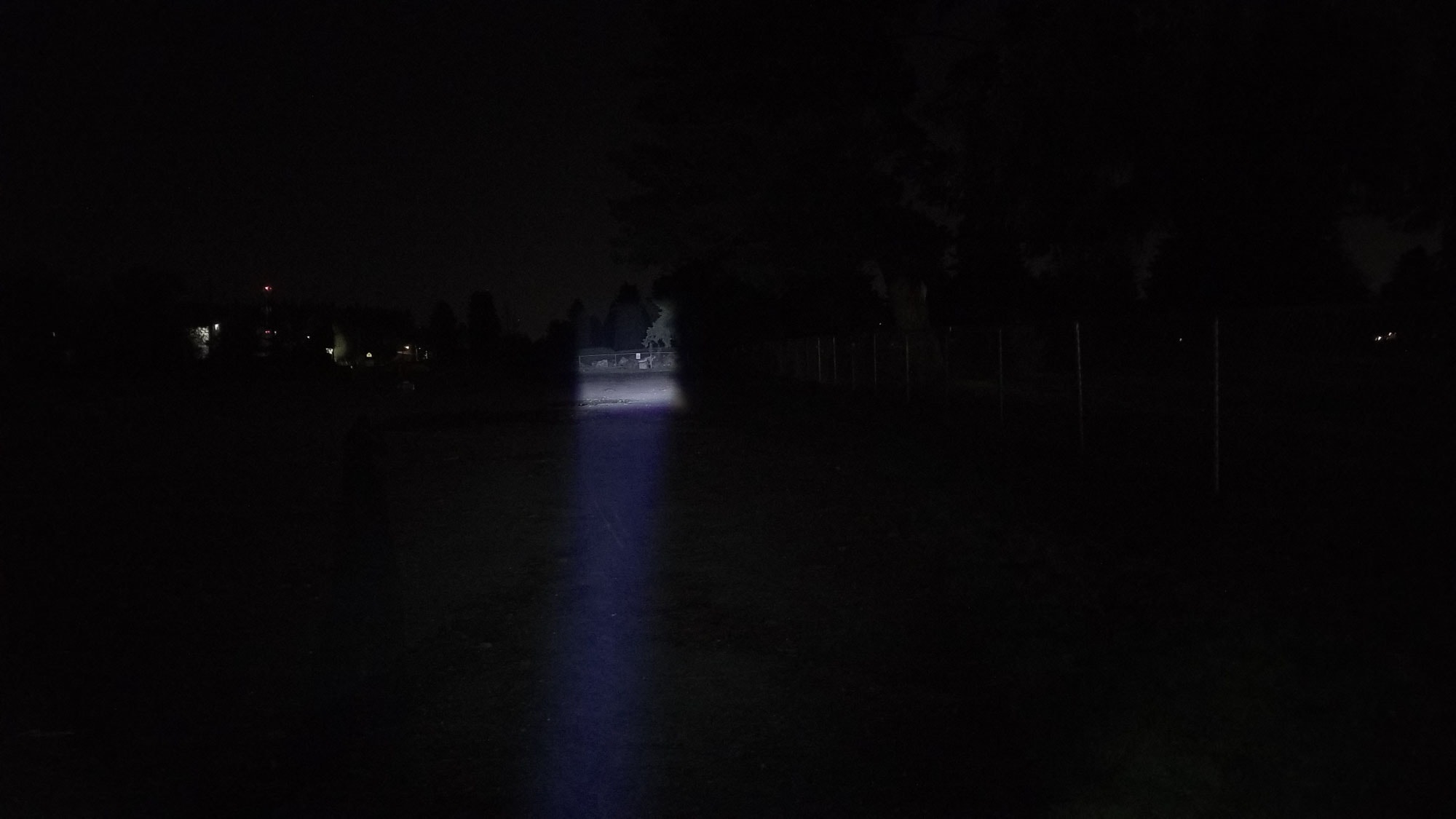
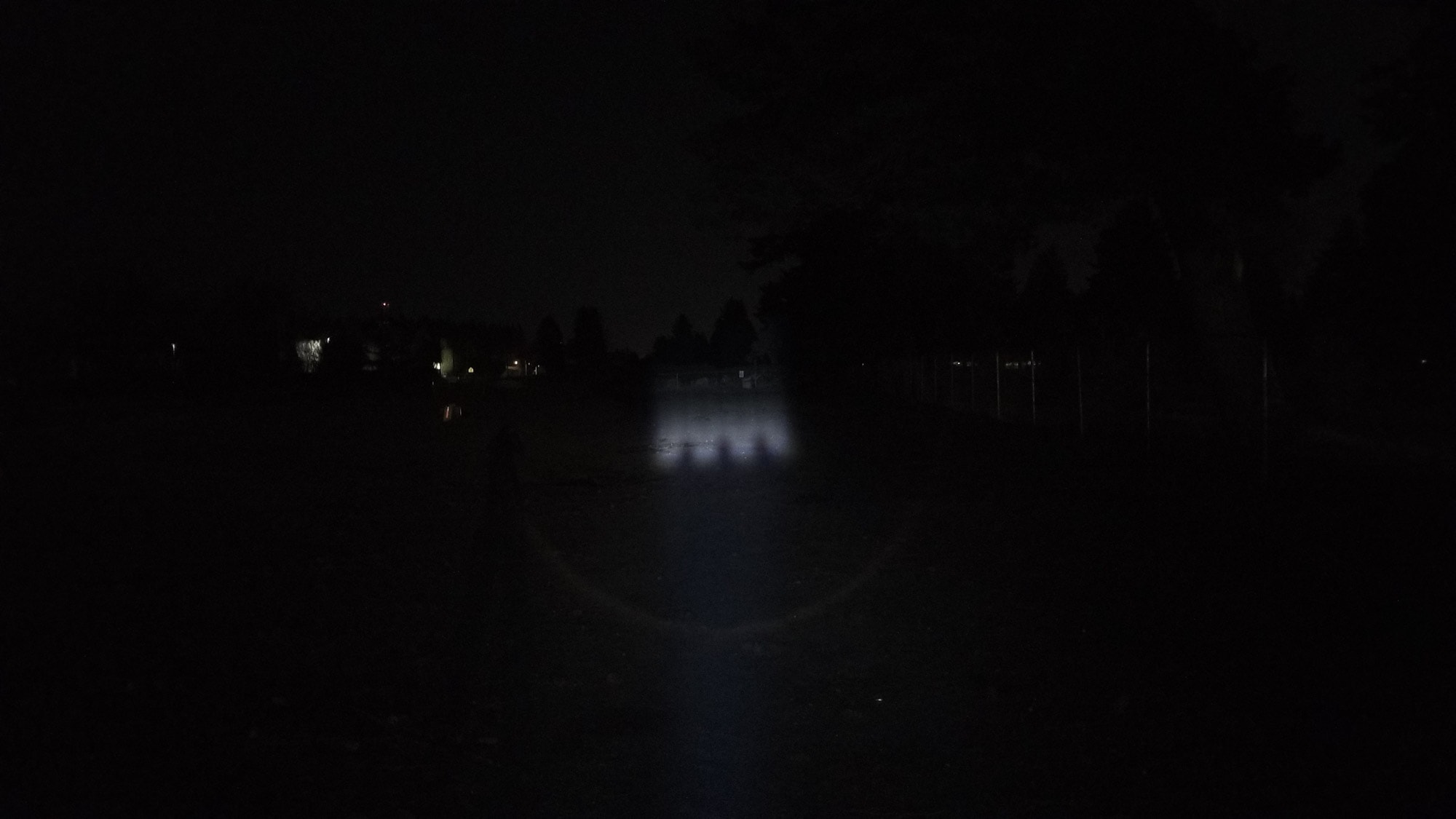
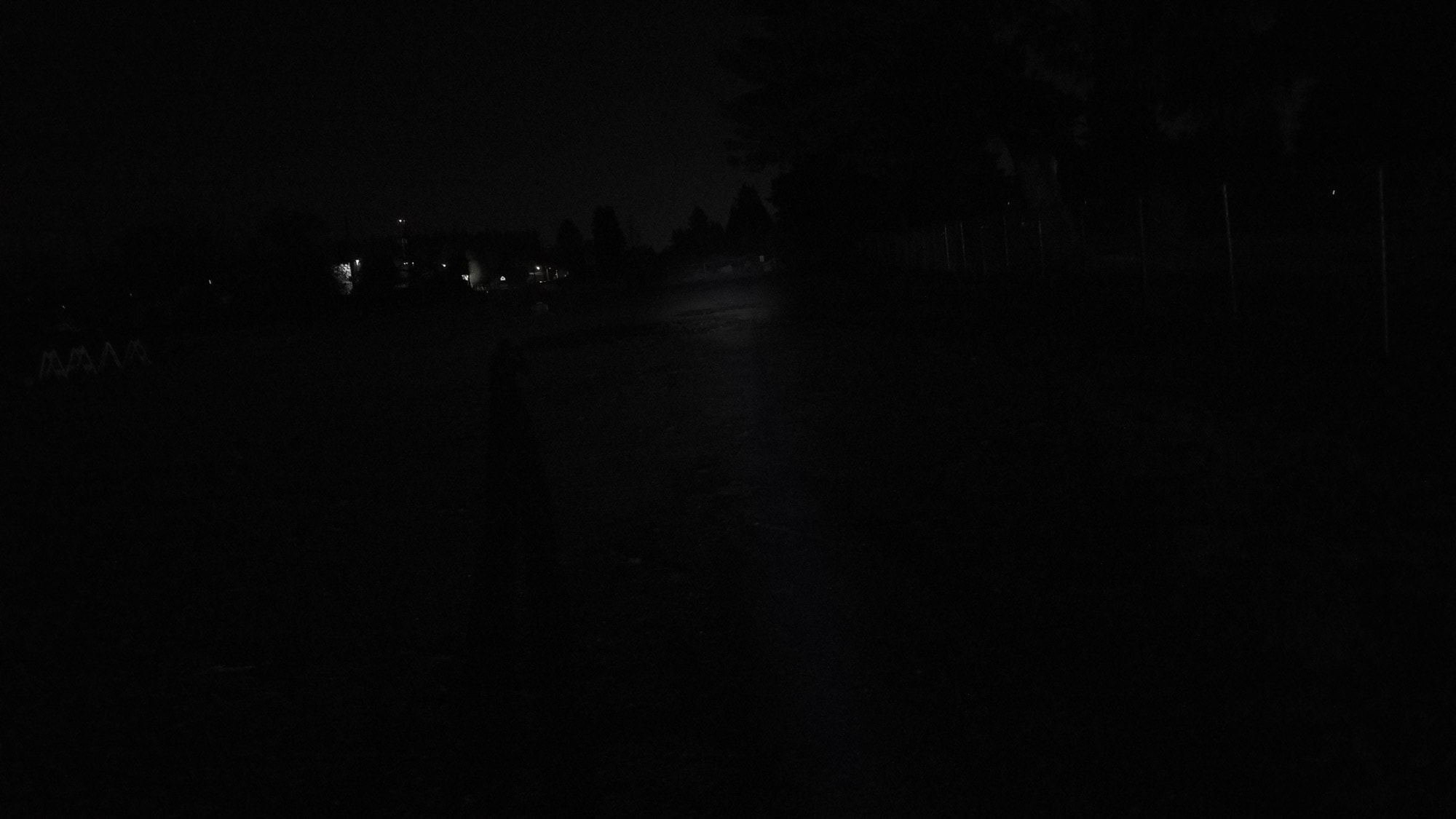
Disclaimer: we bought this flashlight with our own money. Nobody paid us to review this flashlight, nor have I been holding back on problems or defects.
Final Verdict
Pros
- Okay build quality
- Throws pretty good
- Nice clean beam with lots of flood
- Really simple UI with no blinkies!
- Decent performance
Cons
- Bad PWM in Low and Medium modes
- Only takes AA batteries
- Build quality is just okay
- Cheap, unregulated driver
- Plastic lens
- Battery carrier tore up my NiMH batteries
- LED-shaped hotspot
Explanation on star ratings:
1: Avoid: my phone flashlight would be a better choice – 2: Poor: significant defect or issues; almost unusable – 3: Average: some defects or issues; but still usable 4: Good: recommended (minor issues) – 5: Great: highly recommended

2.5 stars: ★★⋆
Okay, wrapping up another most-popular-flashlight-sold-on-Amazon review. If you’re looking for a cheap light that will light up dark places really well, project a LED-shaped area of light a good distance, run well with cheap Alkaline batteries, and generally sit unused for long periods, then go ahead and grab an S2000 and go on your way. Most people who buy these don’t know what a good flashlight is, and won’t care about ugly tints and beams, water resistance, PWM, and zoomie-erific beams.
Like the S1000, it was both enlightening and enriching.
Takeaways?
Well, just because random ‘experts’ say this is the bees-knees, in reality when you evaluate it and compare it to other options, it’s not so much. However, I’m a bit surprised with the S2000’s performance in some areas. The throw figures were impressive, and the beam is nice and artifact-free. Moreover, the NiMH batteries sustained good output for a decent duration. Lastly, if you got the urge to blow money on the S2000, it’s an interesting modding host since the LED and driver can be swapped, and you could add thermal mass to the pill. However, it’s limited to AA batteries, and there’s only so much you can do with those. At the end of the day, it’s still a cheap zoomie with a fake Cree LED, bad tint, bad PWM, unregulated driver, and it only takes AA batteries when the competition at least offers lithium-ion support. It’s also huge, and doesn’t make effective use of all that mass. Then there’s the battery carrier.
I feel like I’ve reached an impasse with these cheap lights, but the objective truth remains: Although there’s some bright spots (no pun intended), they’re still nowhere near as good as an affordable name-brand flashlight. These cheap lights sacrifice a lot: tint, beam profile, thermal performance, output, runtime, and other features like water resistance, onboard charging and superior build quality and functionality. With lights like the Sofirn SC31T, SP35, Wuben C2, and the myriad of Convoy and similar C8-style lights, all coming in $5 to $20 more than the S2000, just like the S1000, I can’t recommend it and give it 2.5 stars.
Gearlight S2000 for sale
If you still want to order it, or just read some Amazon reviews for fun, go ahead:
1lumen selects and reviews products personally. We may earn affiliate commissions through our links, which help support our testing.